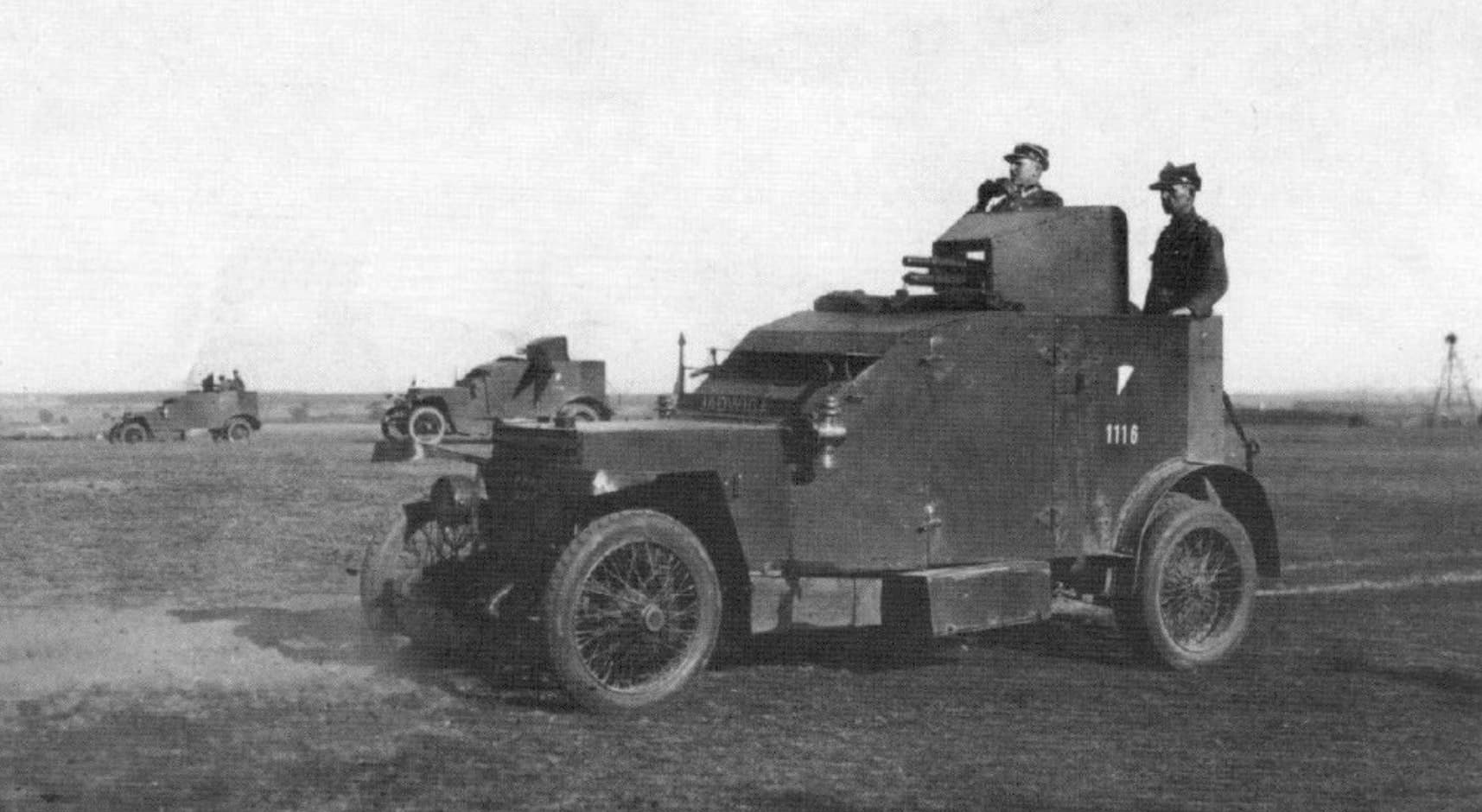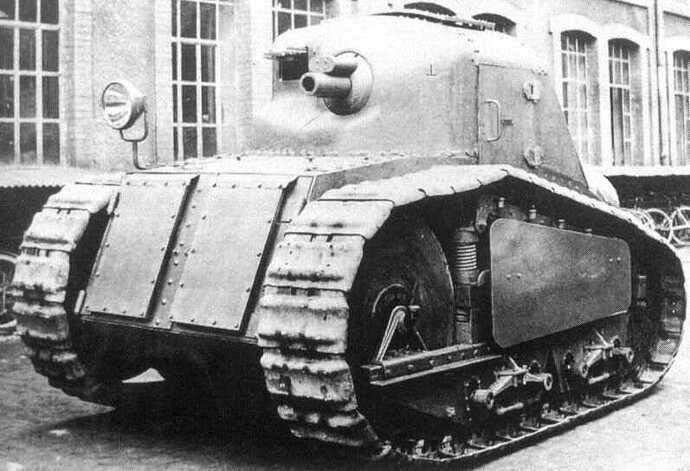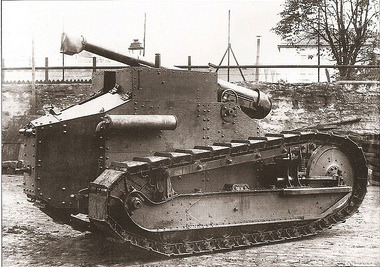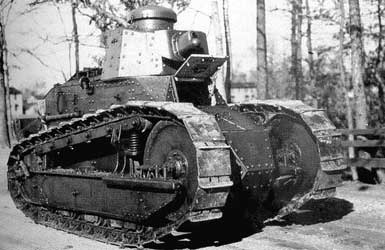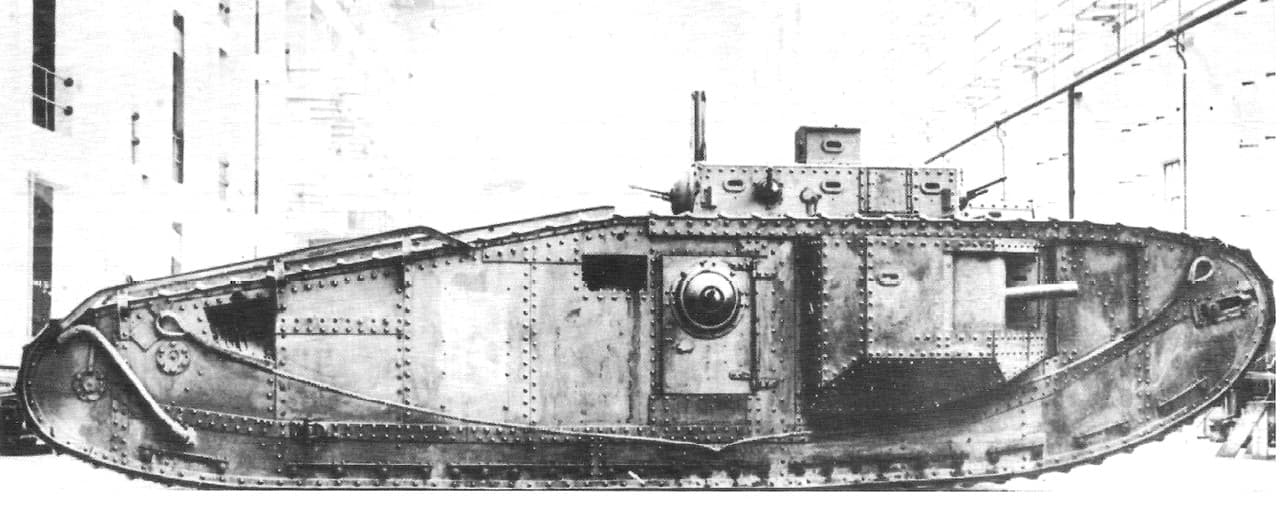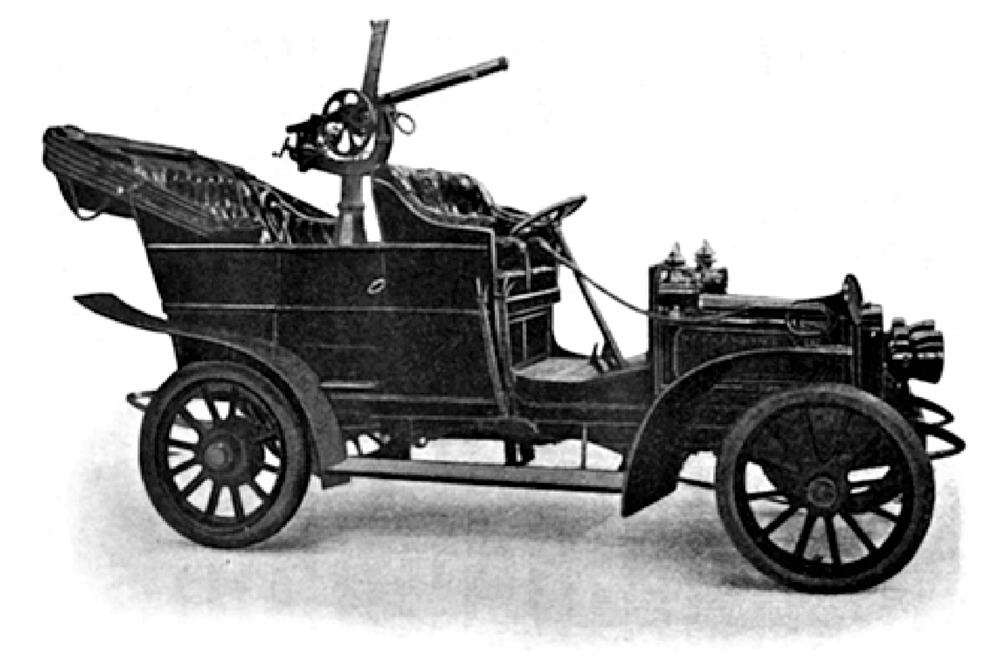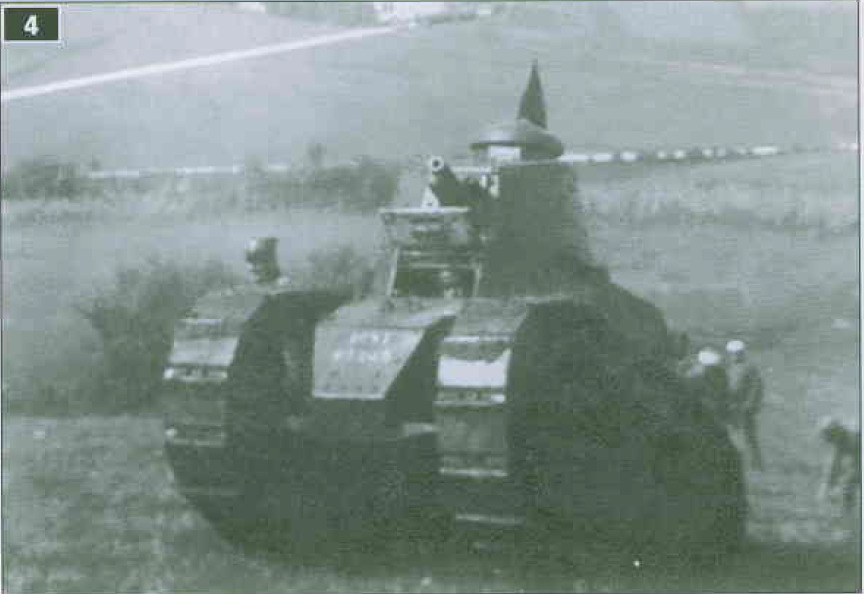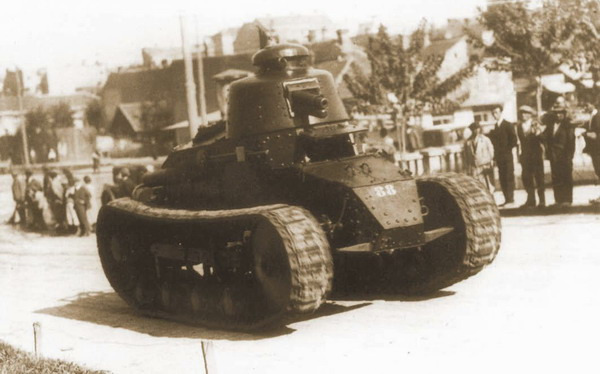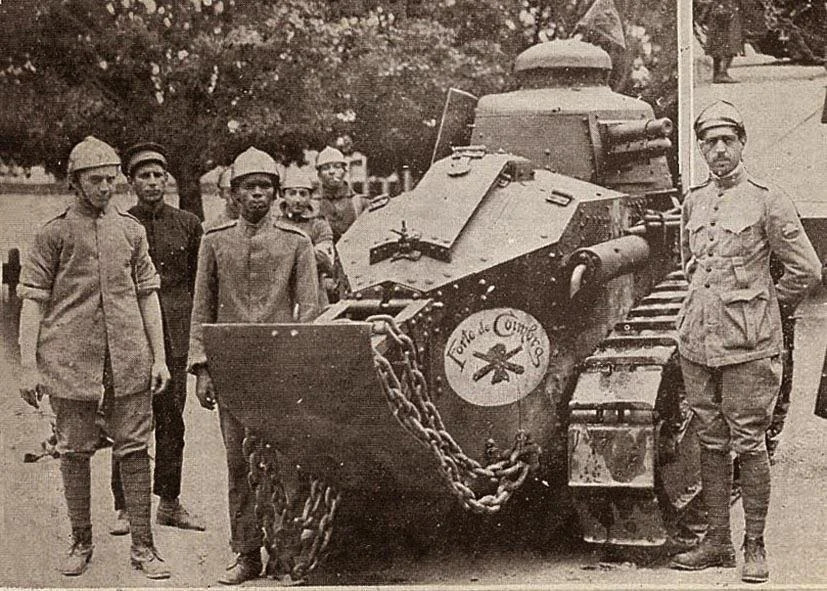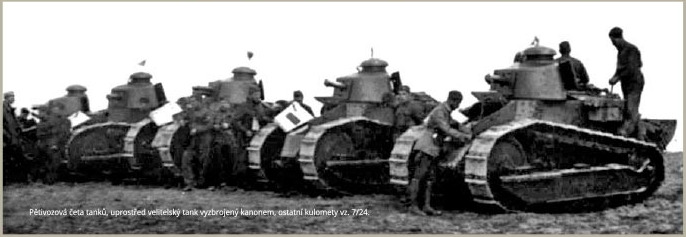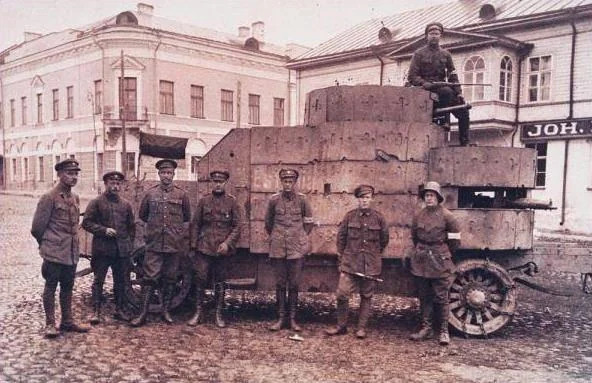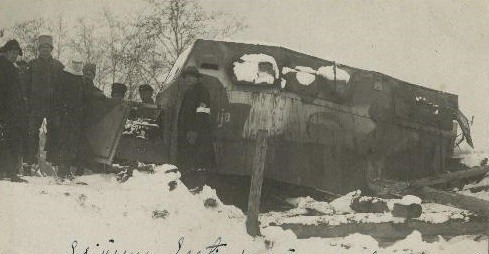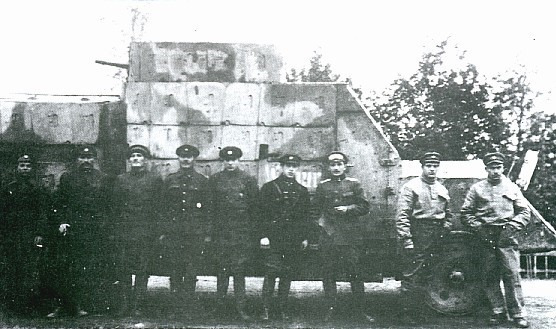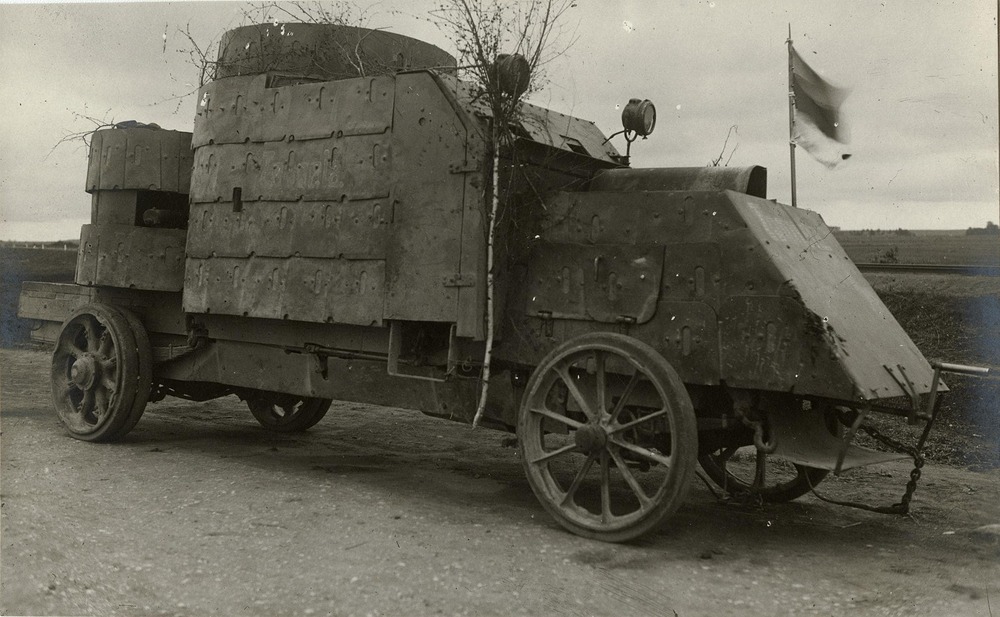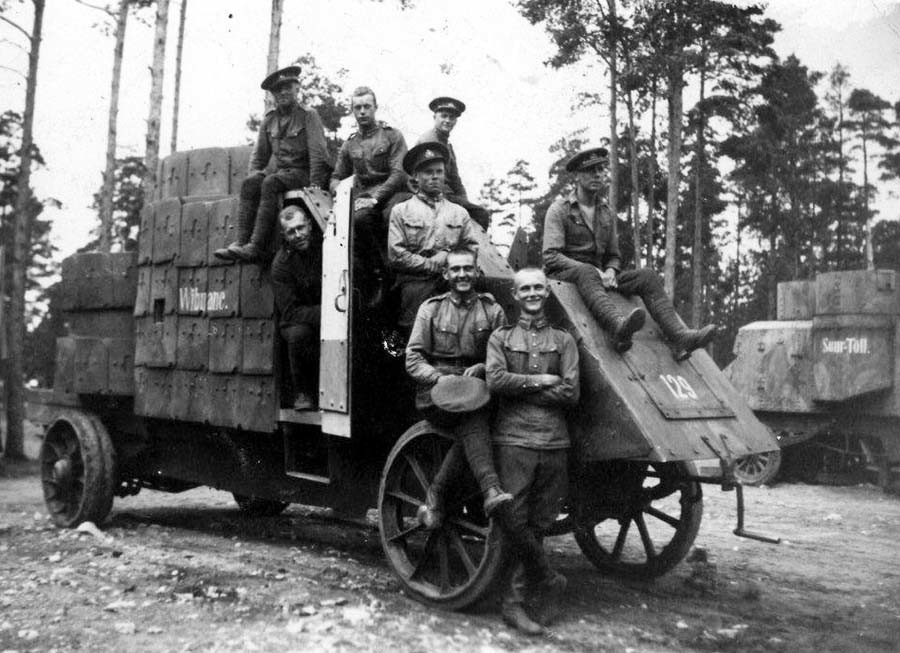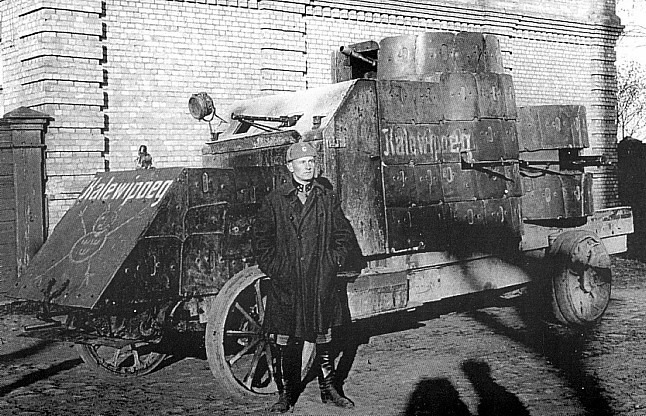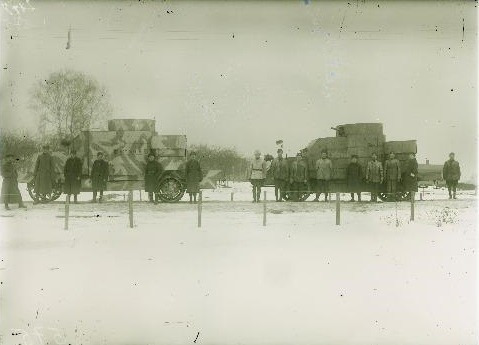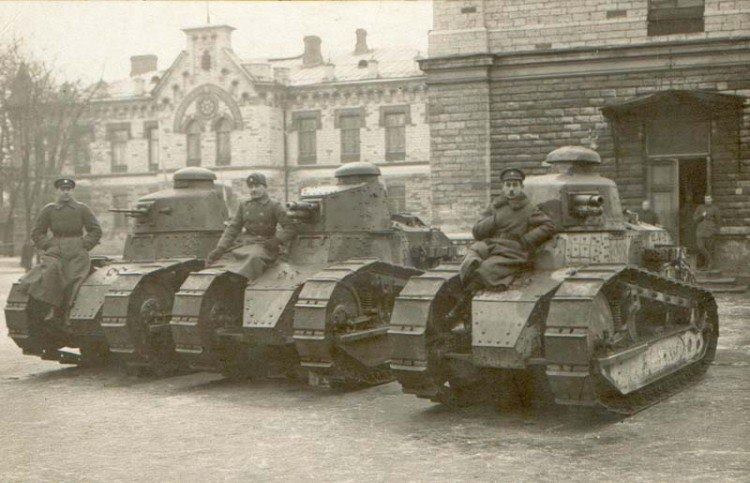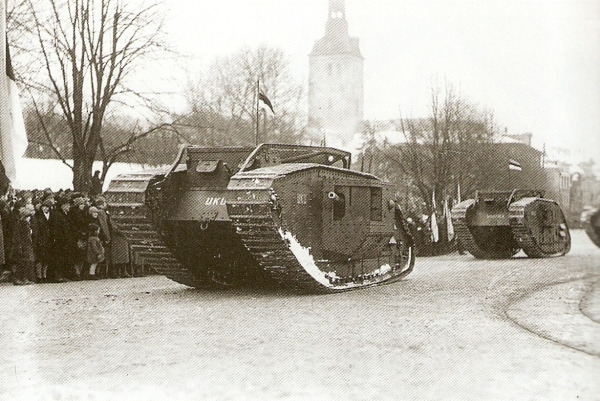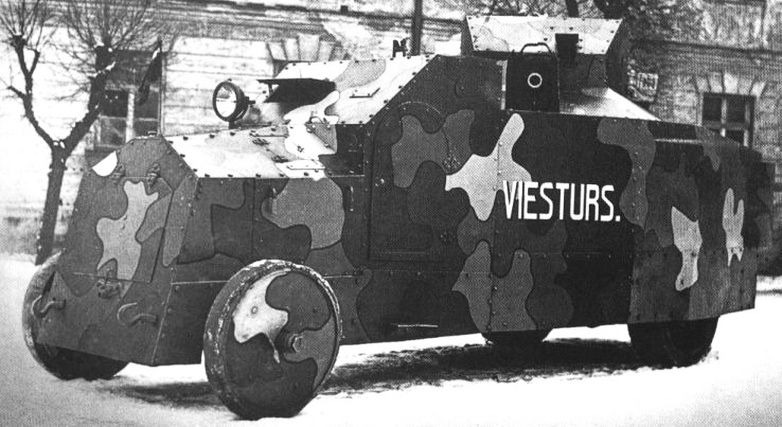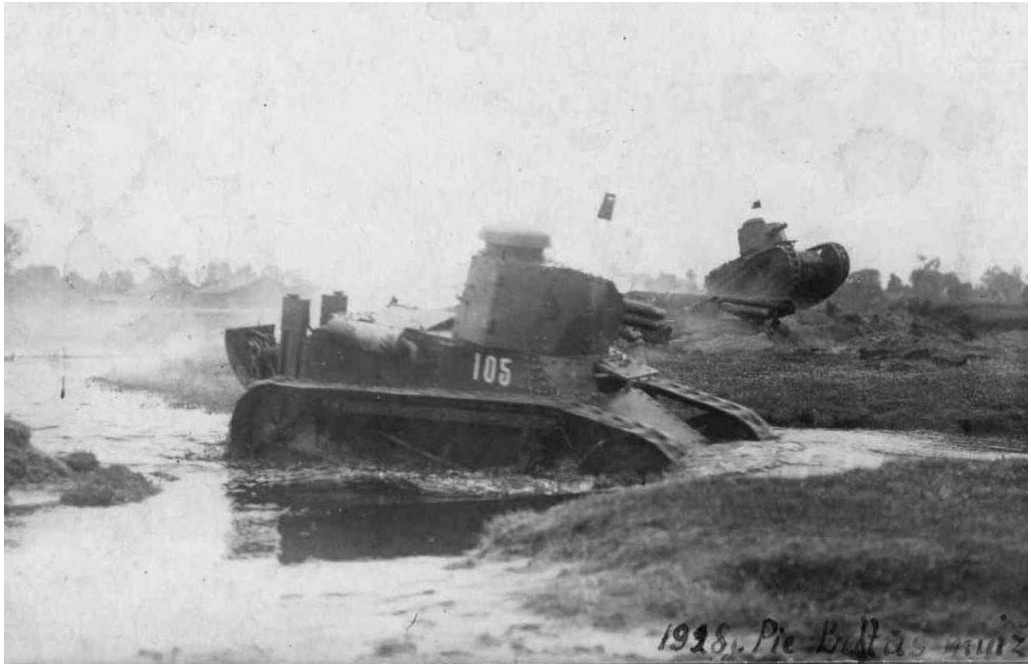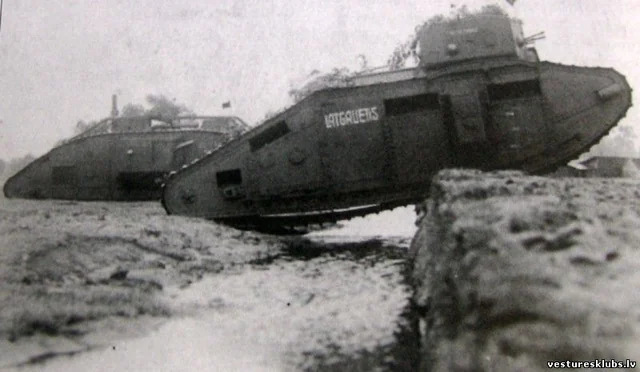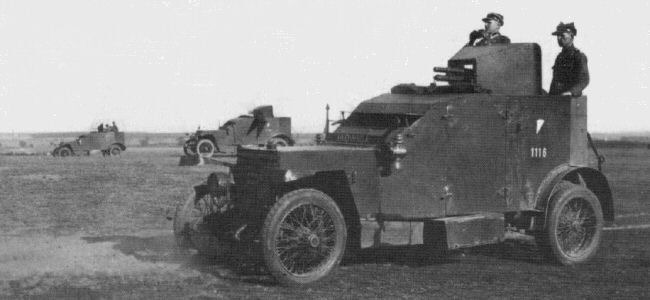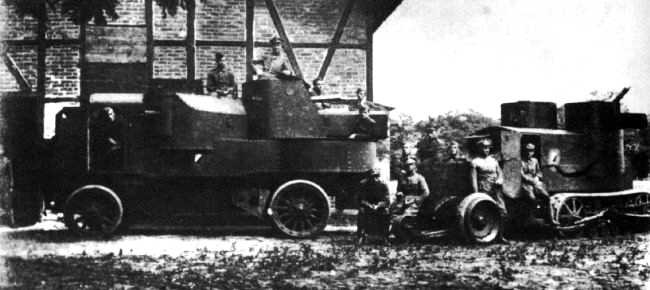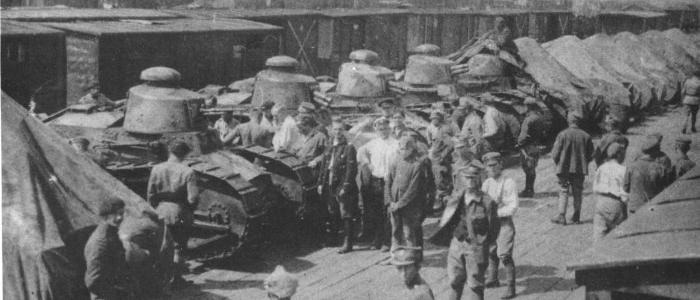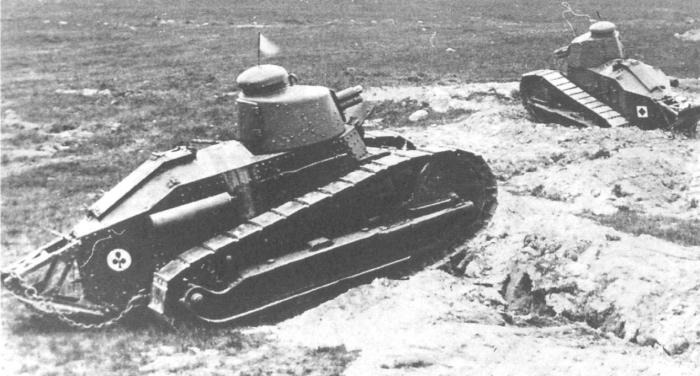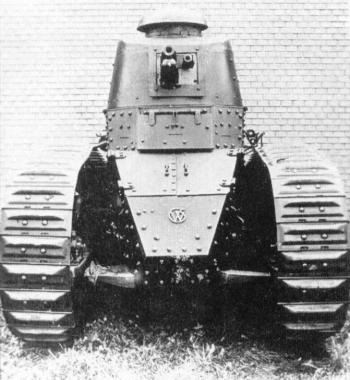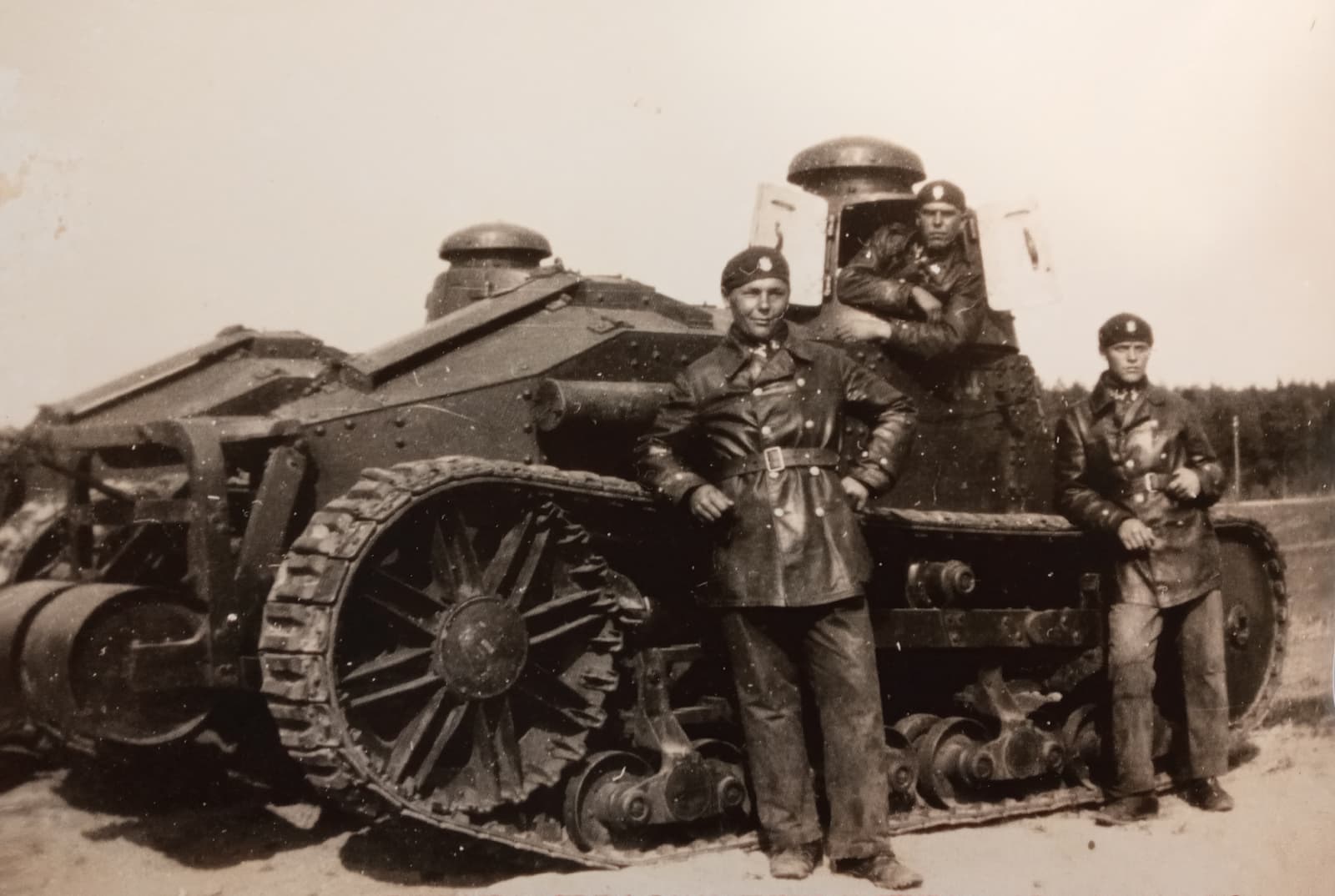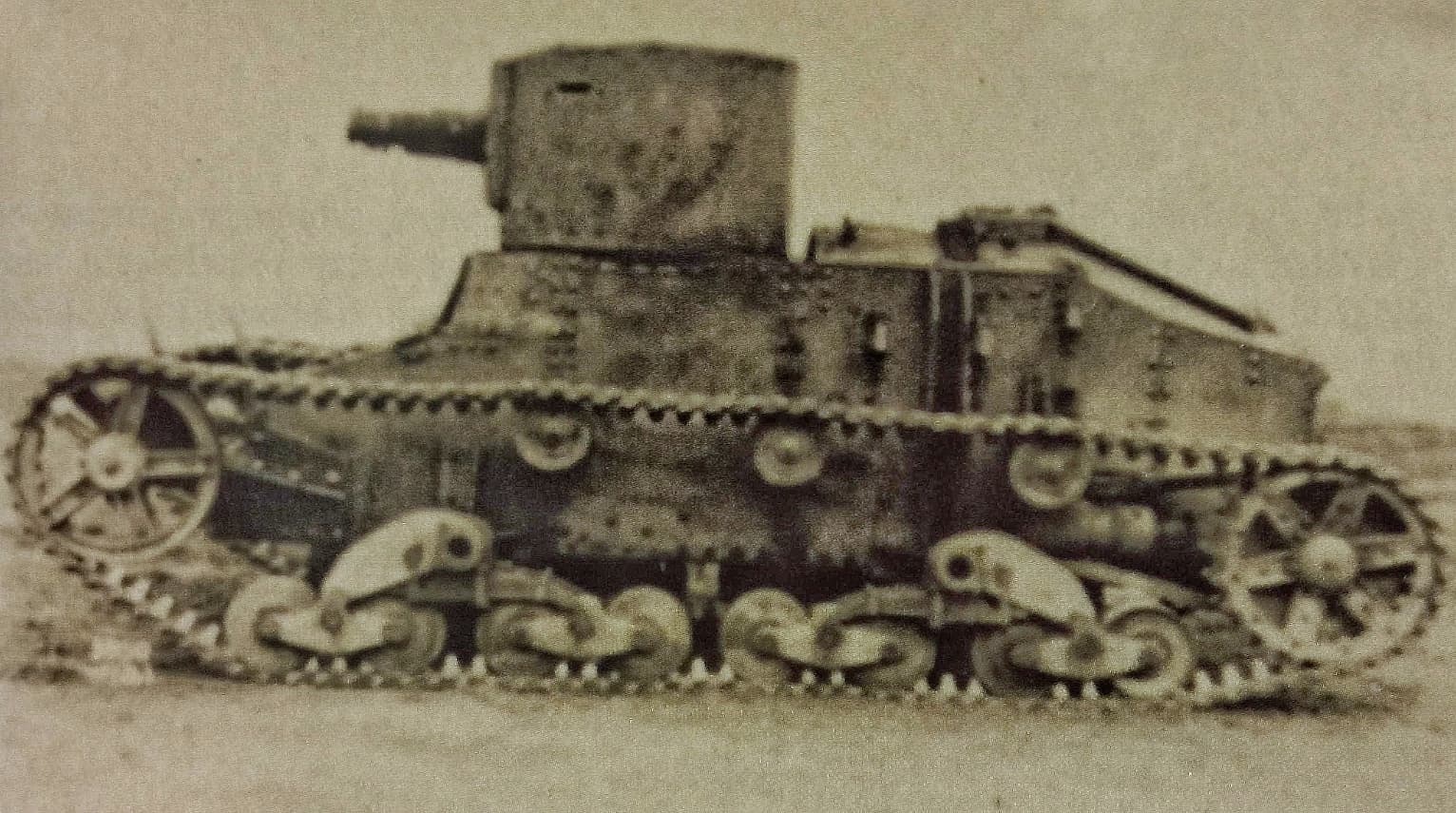ARMORED CARS
Minerva

| General |
|
|
|
| Name(s): |
Panzerwagen Minerva (Beute) (Pzw. Minerva (Beute)) |
|
|
| Type: |
Armored car |
|
|
| Status: |
Captured |
|
|
| Derived From: |
Minerva 16CV |
|
|
| Derivatives: |
None |
|
|
| Produced: |
30~ |
Production Date: |
1914 |
| Producer(s): |
Kingdom of Belgium |
30 |
1914 |
|
Cockerill-Sambre |
30~ |
1914 |
| Used: |
3 |
Service Date: |
1914-6/1919 |
| User(s): |
Duetches Heer (German Army) |
1914-11/1918 |
|
|
Freikorps (Free Corps) |
12/1918-6/1919 |
|
Full User(s) List
| – |
Unit |
Date |
Status |
| User(s): |
Duetches Heer (German Army) |
|
|
|
??? |
|
|
|
Freikorps (Free Corps) |
|
|
|
Kommando der Kampfwagen (Kokampf) |
12/1918-6/1919 |
Disbanded |
| Dimensions |
|
|
|
| Weight: |
4.0 t |
|
|
| Ground Pressure: |
??? kg/cm² |
|
|
|
Length |
Width |
Height |
| Vehicle: |
4.9 m |
1.75 m |
2.3 m |
| Ground Clearance: |
??? cm |
|
|
| Armaments |
|
|
|
|
# of |
Munition (Ammo #) |
Location(s), Type, Horizontal |
Type, Vertical |
Firing Rate |
| Original |
|
|
|
|
1 x |
8 Hotchkiss mle 1909 (???) |
Turret, Manual, -/+360° @ ??°/s |
Manual, -??°/+??° @ ??°/s |
400 rpm |
| Converted |
|
|
|
|
1 x |
2cm Becker K. M2 (300~) |
Turret, Manual, 360° @ ??°/s |
Manual, -??°/+??° @ ??°/s |
325 rpm |
| Ammunition |
|
|
|
|
Bullet |
Type |
Weight/Filler, Penetration @ Velocity |
| Converted |
|
|
|
| 20 mm Gun |
|
|
|
|
2cm Pz. Gß. L’Spur. M2 |
AP-T |
0.145 kg, 18 mm @ 490 m/s |
|
2cm Pz. Gß. L’Spur. M1 |
AP-T |
0.145 kg, 18 mm @ 490 m/s |
|
2cm Sp. Gß. M2 |
HE |
0.137 kg/5 g TNT, 1 mm @ 495 m/s |
|
2cm Sp. Gß. M1 |
HE |
0.137 kg/5.5 g TNT+0.5 g Pieretic, 1 mm @ 495 m/s |
|
2cm L’Spur. Br. Gß. |
I-T |
0.144 kg/11 g Shellac, 14 mm @ 490 m/s |
|
2cm Br. Gß. |
I |
0.137 kg/12 g Incendiary, 13 mm @ 490 m/s |
| Devices |
|
|
| # of - Name |
Type |
Effect, Location/for |
| 1 x - iron sight |
Sight |
1x zoom, for 2cm Becker |
| Protection |
|
|
| Location |
Thickness |
Type |
| ??? |
4 mm @ ??° |
RHA |
| Crew |
|
| 4 |
Total |
| 1 |
Commander |
| 1 |
Driver |
| 1 |
Gunner |
| 1 |
Gun Loader |
| Automotive |
|
|
|
| Fuel Capacity: |
??? l |
|
|
| Engine(s): |
1 x - Minerva |
|
|
|
Type: |
Gasoline |
|
|
Horsepower: |
30 kW |
|
|
@ RPM |
2,500 |
|
|
Cylinder: |
4 |
|
|
Capacity: |
8 l |
|
|
|
Foward |
Reverse |
| Transmission: |
??? |
?? |
?? |
| Steering: |
??? |
|
|
| Brakes: |
??? |
|
|
| Suspension |
|
|
| Type: |
Leaf spring |
|
| Road wheels: |
4x2 |
|
|
Type: |
Spoke |
|
Steering: |
Front wheels |
| Mobility |
|
|
| Maximum Forward Speed: |
40.0 km/h |
|
| Maximum Reverse Speed: |
??? km/h |
|
| Power-to-Weight Ratio: |
7.5 kW/t |
|
| Maximum Grade: |
??° |
|
| Maximum Trench: |
??? m |
|
| Maximum Wall: |
??? m |
|
| Maximum Fording: |
??? cm |
|
| Minimum Turning Diameter: |
??? m |
|
| Cruising Range: |
150 km |
|
|
Mileage: |
??? l/100 km |
Summary
The Minerva were the first deployed armored cars of the First World War and among the first to be captured by German forces during their invasion of Belgium in the opening stages of it. Three were captured, which would later be used during the invasion of Romania in 1916, and at least one would survive up until 1919 when it formed a part of the “Kokampf” Friekorps during the German Revolution. It was later turned over to Entente forces due to the restrictions of the Treaty of Versailles.
Variants & Changes:
- 1914-1916: captured Minerva converted to use a 2cm Becker K. M2 in place of the 8 Hotchkiss mle 1909
Packard
| General |
|
|
|
| Name(s): |
Panzerwagen Packard (Beute) (Pzw. Packard (Beute)) |
|
|
| Type: |
Armored car |
|
|
| Status: |
Captured |
|
|
| Derived From: |
Packard 3 t |
|
|
| Derivatives: |
None |
|
|
| Produced: |
2 |
Production Date: |
1914-3/1915 |
| Producer(s): |
Russian Empire |
2 |
1914-3/1915 |
|
Izhorskij Zavod |
2 |
1914-3/1915 |
| Used: |
2 |
Service Date: |
1918-6/1919 |
| User(s): |
Duetches Heer (German Army) |
1918-11/1918 |
|
|
Freikorps (Free Corps) |
12/1918-6/1919 |
|
Full User(s) List
| – |
Unit |
Date |
Status |
| User(s): |
Duetches Heer (German Army) |
|
|
|
??? |
|
|
|
Freikorps (Free Corps) |
|
|
|
Kommando der Kampfwagen (Kokampf) |
12/1918-6/1919 |
Disbanded |
| Dimensions |
|
|
|
| Weight: |
5.76 t |
|
|
| Ground Pressure: |
??? kg/cm² |
|
|
|
Length |
Width |
Height |
| Vehicle: |
??? m |
??? m |
??? m |
| Ground Clearance: |
??? cm |
|
|
| Armaments |
|
|
|
|
# of |
Munition (Ammo #) |
Location(s), Type, Horizontal |
Type, Vertical |
Firing Rate |
| Original |
|
|
|
|
1 x |
37-mm Maxim-Nordenfelt (1,200) |
Turret, Manual, -/+300° @ ??°/s |
Mechanical, -??°/+??° @ ??°/s |
300 rpm |
1 x |
7,62-mm PM obr. 1910 g. (8,000) |
Moveable, Manual, -/+360° @ 60°/s |
Manual, -10°/+70° @ 60°/s |
600 rpm |
| Converted |
|
|
|
|
1 x |
2cm Becker K. M2 (2,400) |
Turret, Manual, -/+300° @ ??° |
Mechanical, -??°/+??° @ ??°/s |
325 rpm |
3 x |
M. G. 08 (???) |
Front Turret, Manual, ???° @ 60°/s |
Manual, -??°/+??° @ 60°/s |
500 rpm |
|
|
Right Pintle, Manual, ???° @ 60°/s |
Manual, -??°/+??° @ 60°/s |
500 rpm |
|
|
Rear Pintle, Manual, ???° @ 60°/s |
Manual, -??°/+??° @ 60°/s |
500 rpm |
| Ammunition |
|
|
|
|
Bullet |
Type |
Weight/Filler, Penetration @ Velocity |
| Original |
|
|
|
| 37 mm Gun |
|
|
|
|
3,7cm L’Spur.-Gr. L/2,5 (St.) |
AP-T |
0.465 kg, 26 mm @ 550 m/s |
|
3,7cm Sprg. L/2,5 (Kz.) |
HE/-BF |
0.47 kg/42 g Pieretic, 7/16 mm @ 550 m/s |
| Converted |
|
|
|
| 20 mm Gun |
|
|
|
|
2cm Pz. Gß. L’Spur. M2 |
AP-T |
0.145 kg, 18 mm @ 490 m/s |
|
2cm Pz. Gß. L’Spur. M1 |
AP-T |
0.145 kg, 18 mm @ 490 m/s |
|
2cm Sp. Gß. M2 |
HE |
0.137 kg/5 g TNT, 1 mm @ 495 m/s |
|
2cm Sp. Gß. M1 |
HE |
0.137 kg/5.5 g TNT+0.5 g Pieretic, 1 mm @ 495 m/s |
|
2cm L’Spur. Br. Gß. |
I-T |
0.144 kg/11 g Shellac, 14 mm @ 490 m/s |
|
2cm Br. Gß. |
I |
0.137 kg/12 g Incendiary, 13 mm @ 490 m/s |
| Devices |
|
|
| # of - Name |
Type |
Effect, Location/for |
| Original |
|
|
| 1 x - ??? |
Sight |
??x zoom, for 37-mm Maxim-Nordenfelt |
| Converted |
|
|
| 1 x - iron sight |
Sight |
1x zoom, for 2cm Becker |
| Protection |
|
|
| Location |
Thickness |
Type |
| Frontwards |
|
|
| All front |
5 mm @ ??° |
Chrome-nickel |
| Sidewards |
|
|
| All side |
4 mm @ ??° |
Chrome-nickel |
| Turret side |
5 mm @ ??° |
Chrome-nickel |
| Rearwards |
|
|
| All rear |
4 mm @ ??° |
Chrome-nickel |
| Turret rear |
5 mm @ ??° |
Chrome-nickel |
| Upwards |
|
|
| Roof |
4 mm @ ??° |
Chrome-nickel |
| Crew |
|
| 7 |
Original |
| 1 |
Commander |
| 1 |
Driver |
| 1 |
Gunner |
| 2 |
Gun Loader |
| 1 |
Machine Gunners |
| 1 |
Machine Gun Loader |
| 10 |
Converted |
| 1 |
Commander |
| 1 |
Driver |
| 1 |
Gunner |
| 2 |
Gun Loader |
| 2 |
Machine Gunners |
| 2 |
Machine Gun Loader |
| 1 |
Machine Gunner, Machine Gun Loader |
| Automotive |
|
|
|
| Fuel Capacity: |
??? l |
|
|
| Engine(s): |
1 x - Packard |
|
|
|
Type: |
Gasoline |
|
|
Horsepower: |
24 kW |
|
|
@ RPM |
??? |
|
|
Cylinder: |
4 |
|
|
Capacity: |
??? l |
|
|
|
Foward |
Reverse |
| Transmission: |
??? |
?? |
?? |
| Steering: |
??? |
|
|
| Brakes: |
??? |
|
|
| Suspension |
|
|
| Type: |
Leaf spring |
|
| Road wheels: |
4x2 |
|
|
Type: |
Solid |
|
Steering: |
Front wheels |
| Mobility |
|
|
| Maximum Forward Speed: |
50.0 km/h |
|
| Maximum Reverse Speed: |
??? km/h |
|
| Power-to-Weight Ratio: |
4.1 kW/t |
|
| Maximum Grade: |
??° |
|
| Maximum Trench: |
??? m |
|
| Maximum Wall: |
??? m |
|
| Maximum Fording: |
??? cm |
|
| Minimum Turning Diameter: |
??? m |
|
| Cruising Range: |
??? km |
|
|
Mileage: |
??? l/100 km |
Summary
In response to the effectiveness of cannon armored cars in 1914, further cannon armored cars were ordered. One model selected were based on Packard trucks and completed by 1915. Due to the chaos of the Russian Revolution and proceeding Civil War, both of the two built armored cars were captured and converted to be 2cm gun carriers. As a part of the “Kokampf,” they were deployed in Berlin during the German Revolution and later turned over to Entente forces due to the restrictions of the Treaty of Versailles.
Variants & Changes:
- 1918: captured Packard converted to use a 2cm Becker K. M2 in place of the 37-mm Maxim-Nordenfelt, and three M. G. 08 in place of the single 7,62-mm PM-10
Variant Images
Before modification upon capture.

After modification in 1918.
Pierce-Arrow

| General |
|
|
|
| Name(s): |
Panzerwagen Pierce-Arrow (Beute) (Pzw. Pierce-Arrow (Beute)) |
|
|
| Type: |
Armored car |
|
|
| Status: |
Produced |
|
|
| Derived From: |
Pierce-Arrow 5 t |
|
|
| Derivatives: |
None |
|
|
| Produced: |
2 |
Production Date: |
1916 |
| Producer(s): |
Russian Empire |
2 |
1916 |
|
Izhorskij Zavod |
2 |
1916 |
| Used: |
2 |
Service Date: |
1918-1919 |
| User(s): |
Duetches Heer (German Army) |
1918 |
|
|
Freikorps (Free Corps) |
12/1918-6/1919 |
|
Full User(s) List
| – |
Unit |
Date |
Status |
| User(s): |
Duetches Heer (German Army) |
|
|
|
??? |
|
|
|
Freikorps (Free Corps) |
|
|
|
??? |
|
|
| Dimensions |
|
|
|
| Weight: |
??? t |
|
|
| Ground Pressure: |
??? kg/cm² |
|
|
|
Length |
Width |
Height |
| Vehicle: |
??? m |
??? m |
??? m |
| Ground Clearance: |
??? cm |
|
|
| Armaments |
|
|
|
|
| # of |
Munition (Ammo #) |
Location(s), Type, Horizontal |
Type, Vertical |
Firing Rate |
| Original |
|
|
|
|
| 1 x |
76.2-mm obr. 1904 g. (???) |
Turret, Mechanical, -/+???° @ ??°/s |
Mechanical, -??°/+??° @ ??°/s |
6 rpm |
| 2 x |
7,62-mm PM obr. 1910 g. (???) |
Sponsons, Mechanical, -/+???° @ ??°/s |
Manual, -??°/+??° @ 60°/s |
600 rpm |
| Converted |
|
|
|
|
| 1 x |
76.2-mm obr. 1904 g. (???) |
Turret, Mechanical, -/+???° @ ??°/s |
Mechanical, -??°/+??° @ ??°/s |
6 rpm |
| 2 x |
M. G. 08 (???) |
Sponsons, Mechanical, -/+???° @ ??°/s |
Manual, -??°/+??° @ 60°/s |
600 rpm |
| Ammunition |
|
|
|
|
Bullet |
Type |
Weight/Filler, Penetration @ Velocity |
| 76.2 mm Gun |
|
|
|
|
Grenade 76,2-mm |
HE |
6.4 kg/785 g TNT, 24 mm @ 290 m/s |
|
Shrapnel 76,2-mm |
Sh |
6.5 kg/85 g TNT, ??? mm @ 290 m/s |
| Devices |
|
|
| # of - Name |
Type |
Effect, Location/for |
| 1 x - ??? |
Sight |
??x zoom, for 76.2-mm obr. 1904 g. |
| Protection |
|
|
| Location |
Thickness |
Type |
| Frontwards |
|
|
| All front |
4.5 mm @ ??° |
RHA |
| Sidewards |
|
|
| All side |
4.5 mm @ ??° |
RHA |
| Rearwards |
|
|
| All rear[/u] |
4.5 mm @ ??° |
RHA |
| Upwards[/u] |
|
|
| Roof |
4.5 mm @ ??° |
RHA |
| Crew |
|
| 6[/u] |
Total |
| 1 |
Commander |
| 1 |
Driver |
| 1 |
Gunner |
| 2 |
Gun Loaders |
| 2 |
Machine Gunners, Machine Gun Loaders |
| Automotive |
|
|
|
| Fuel Capacity: |
??? l |
|
|
| Engine(s): |
1 x - ??? |
|
|
|
Type: |
Gasoline |
|
|
Horsepower: |
??? kW |
|
|
@ RPM: |
??? |
|
|
Cylinder: |
4 |
|
|
Capacity: |
??? l |
|
|
|
Foward |
Reverse |
| Transmission: |
??? |
?? |
?? |
| Steering: |
??? |
|
|
| Brakes: |
??? |
|
|
| Suspension |
|
|
| Type: |
Leaf spring |
|
| Road wheels: |
4x2 |
|
|
Type: |
Solid |
|
Steering: |
Front wheels |
| Mobility |
|
|
| Maximum Forward Speed: |
??? km/h |
|
| Maximum Reverse Speed: |
??? km/h |
|
| Power-to-Weight Ratio: |
??? kW/t |
|
| Maximum Grade: |
??° |
|
| Maximum Trench: |
??? m |
|
| Maximum Wall: |
??? m |
|
| Maximum Fording: |
??? cm |
|
| Minimum Turning Diameter: |
??? m |
|
| Cruising Range: |
??? km |
|
|
Mileage: |
??? l/100 km |
Summary
A single Pierce-Arrow was captured from the Russians in 1918. After being repaired, it saw service in the rear areas before being deployed in Berlin as a part of the Freikorps during the German revolution. It was presumably turned over to the Entente after the Treaty of Versailles.
Variants & Changes:
None
Garford

| General |
|
|
|
| Name(s): |
Panzerwagen Garford (Beute) (Pzw. Garford (Beute)) |
|
|
| Type: |
Armored car |
|
|
| Status: |
Captured |
|
|
| Derived From: |
Garford HtK 68 |
|
|
| Derivatives: |
None |
|
|
| Produced: |
30 |
Production Date: |
3/1915-28/9/1915 |
| Producer(s): |
Russian Empire |
30 |
3/1915-28/9/1915 |
|
Putilovskij Zavod |
30 |
3/1915-28/9/1915 |
| Used: |
3 |
Service Date: |
1916/1918-1919 |
| User(s): |
Duetches Heer (German Army) |
1916/1918-11/1918 |
|
|
Freikorps (Free Corps) |
12/1918-6/1919 |
|
Full User(s) List
| – |
Unit |
Date |
Status |
| User(s): |
Duetches Heer (German Army) |
|
|
|
??? |
|
|
|
Freikorps (Free Corps) |
|
|
|
Kommando der Kampfwagen (Kokampf) |
12/1918-6/1919 |
Disbanded |
| Dimensions |
|
|
|
| Weight: |
8.6 t |
|
|
| Ground Pressure: |
??? kg/cm² |
|
|
|
Length |
Width |
Height |
| Vehicle: |
5.7 m |
2.3 m |
2.8 m |
| Ground Clearance: |
30 cm |
|
|
| Armaments |
|
|
|
|
# of |
Munition (Ammo #) |
Location(s), Type, Horizontal |
Type, Vertical |
Firing Rate |
| Original |
|
|
|
|
1 x |
76,2-mm obr. 1910 g. (44) |
Turret, Mechanical, -/+260° @ 12.8°/s |
Mechanical, -5°/+15° @ 3.2°/s |
15 rpm |
3 x |
7,62-mm PM obr. 1910 g. (6,000) |
Coaxial, Manual, -/+5° @ 60°/s |
Manual, -5°/+15° @ 60°/s |
600 rpm |
|
|
Sponsons, Manual, -/+81° @ 60°/s |
Manual, -4°/+10° @ 60°/s |
600 rpm |
| Converted |
|
|
|
|
1 x |
76,2-mm obr. 1910 g. (44) |
Turret, Mechanical, -/+260° @ 12.8°/s |
Mechanical, -5°/+15° @ 3.2°/s |
15 rpm |
3 x |
M. G. 08 (6,000) |
Coaxial, Manual, -/+5° @ 60°/s |
Manual, -5°/+15° @ 60°/s |
500 rpm |
|
|
Sponsons, Manual, -/+81° @ 60°/s |
Manual, -4°/+10° @ 60°/s |
500 rpm |
| Ammunition |
|
|
|
|
Bullet |
Type |
Weight/Filler, Penetration @ Velocity |
| 76.2 mm Gun |
|
|
|
|
7,62cm St. Gr. |
HE/SAPHE |
6.0 kg/390 g TNT, 25/35 mm @ 400 m/s |
|
Grenade 76,2-mm |
HE |
6.4 kg/785 g TNT, 24 mm @ 381 m/s |
|
Shrapnel 76,2-mm |
Sh |
6.5 kg/85 g TNT, 18 mm @ 381 m/s |
| Devices |
|
|
| # of - Name |
Type |
Effect, Location/for |
| 1 x - ??? |
Sight |
1-3.5x zoom, for 76,2-mm obr. 1910 g. |
| Protection |
|
|
| Location |
Thickness |
Type |
| Frontwards |
|
|
| All front |
6.5 mm @ 0° |
RHA |
| Sponson |
5 mm @ 0° |
RHA |
| Hood |
5 mm @ 61° (LoS 10 mm) |
RHA |
| Exhaust cover |
3 mm @ 45° (LoS 4 mm) |
RHA |
| Sidewards |
|
|
| All side |
6.5 mm @ 0° |
RHA |
| Sponson |
5 mm @ 0° |
RHA |
| Rear upper panel |
5 mm @ 45° (LoS 7 mm) |
RHA |
| Rear lower panel |
6.5 mm @ 35° (LoS 8 mm) |
RHA |
| Turret side |
6.5 mm @ 20° (LoS 7 mm) |
RHA |
| Rearwards |
|
|
| All rear |
6.5 mm @ 0° |
RHA |
| Turret front |
6.5 mm @ 23° (LoS 7 mm) |
RHA |
| Lower |
3 mm @ 0° |
RHA |
| Upwards |
|
|
| Roof |
3 mm @ 0° |
RHA |
| Downwards |
|
|
| Floor |
3 mm @ 0° |
RHA |
| Crew |
|
| 8 |
Total |
| 1 |
Commander |
| 1 |
Driver |
| 1 |
Gunner |
| 1 |
Gun Loader |
| 2 |
Machine Gunners |
| 2 |
Machine Gun Loaders |
| Automotive |
|
|
|
| Fuel Capacity: |
132.4 l |
|
|
| Engine(s): |
1 x - Putilov |
|
|
|
Type: |
Gasoline |
|
|
Horsepower: |
22 kW |
|
|
@ RPM |
2,500 |
|
|
Cylinder: |
4 |
|
|
Capacity: |
??? l |
|
|
|
Foward |
Reverse |
| Transmission: |
Putilov 4-speed |
4 |
4 |
| Steering: |
??? |
|
|
| Brakes: |
??? |
|
|
| Suspension |
|
|
| Type: |
Leaf spring |
|
| Road wheels: |
4x2 |
|
|
Type: |
Spoked |
|
Steering: |
Front wheels |
| Mobility |
|
|
| Maximum Forward Speed: |
18.0 km/h |
|
| Maximum Reverse Speed: |
18.0 km/h |
|
| Power-to-Weight Ratio: |
2.6 kW/t |
|
| Maximum Grade: |
??° |
|
| Maximum Trench: |
??? m |
|
| Maximum Wall: |
??? m |
|
| Maximum Fording: |
??? cm |
|
| Minimum Turning Diameter: |
??? m |
|
| Cruising Range: |
120 km |
|
|
Mileage: |
??? l/100 km |
Summary
Garford-Putilov formed the largest type of armored cars in the Russian Empire. During the last two years of the First World War, Germany captured five of the thirty cars and converted at least three to use M. G. 08. However, they wouldn’t see much action until the German Revolution, where they were used as a part of the “Kokampf” and later turned over to Entente forces due to the restrictions of the Treaty of Versailles.
Variants & Changes:
- 1916-1918: at least three captured Garford converted to use M. G. 08 in place of the 7,62-mm obr. 1918 g.
Variant Images

A modified Garford a part of the Freikorps “Kokampf.”
Bussing A5P

| General |
|
|
|
| Name(s): |
Panzerwagen Bussing A5P (Pzw. Bussing A5P) |
|
|
| Type: |
Armored car |
|
|
| Status: |
Prototype |
|
|
| Derived From: |
None |
|
|
| Derivatives: |
None |
|
|
| Produced: |
1 |
Production Date: |
1915 |
| Producer(s): |
German Empire |
1 |
1915 |
|
Daimler-Motoren-Gesselschuft |
40 |
1915 |
| Used: |
40 |
Service Date: |
??? |
| User(s): |
Duetches Heer (German Army) |
1915-11/1918 |
|
Full User(s) List
| – |
Unit |
Date |
Status |
| User(s): |
Duetches Heer (German Army) |
|
|
|
??? |
|
|
| Dimensions |
|
|
|
| Weight: |
10.25 t |
|
|
| Ground Pressure: |
??? kg/cm² |
|
|
|
Length |
Width |
Height |
| Vehicle: |
9.5 m |
2.1 m |
3.5 m |
| Ground Clearance: |
??? cm |
|
|
| Armaments |
|
|
|
|
# of |
Munition (Ammo #) |
Location(s), Type, Horizontal |
Type, Vertical |
Firing Rate |
1 x |
2cm Becker K. M2 (???) |
Port*, Manual, ???° @ ??°/s |
Manual, -??°/+??° @ ??°/s |
325 rpm |
2 x |
M. G. 08 (16,700) |
Port*, Manual, -/+???° @ 60°/s |
Manual, -??°/+??° @ 60°/s |
500 rpm |
*Guns have no fixed positions and can be placed in any of twelve gun ports, including: four in the cylindrical tower with one on each side, two in the front and the rear, and two one each side with one of them located on the doors.
| Ammunition |
|
|
|
|
Bullet |
Type |
Weight/Filler, Penetration @ Velocity |
| 20 mm Gun |
|
|
|
|
2cm Pz. Gß. L’Spur. M2 |
AP-T |
0.145 kg, 18 mm @ 490 m/s |
|
2cm Pz. Gß. L’Spur. M1 |
AP-T |
0.145 kg, 18 mm @ 490 m/s |
|
2cm Sp. Gß. M2 |
HE |
0.137 kg/5 g TNT, 1 mm @ 495 m/s |
|
2cm Sp. Gß. M1 |
HE |
0.137 kg/5.5 g TNT+0.5 g Pieretic, 1 mm @ 495 m/s |
|
2cm L’Spur. Br. Gß. |
I-T |
0.144 kg/11 g Shellac, 14 mm @ 490 m/s |
|
2cm Br. Gß. |
I |
0.137 kg/12 g Incendiary, 13 mm @ 490 m/s |
| Devices |
|
|
| # of - Name |
Type |
Effect, Location/for |
| 1 x - ??? |
Sight |
??x zoom, for 2cm Becker K. M2 |
| Protection |
|
|
| Location |
Thickness |
Type |
| Frontwards |
|
|
| All front |
7.5 mm @ ??° |
Chrome Nickel |
| Sidewards |
|
|
| All front |
5.5 mm @ ??° |
Chrome Nickel |
| Rearwards |
|
|
| All front |
7.5 mm @ ??° |
Chrome Nickel |
| Upwards |
|
|
| All front |
3.5 mm @ ??° |
Chrome Nickel |
| Downwards |
|
|
| All front |
??? mm @ ??° |
Chrome Nickel |
| Crew |
|
| 10 |
Total |
| 1 |
Commander |
| 1 |
Front Driver |
| 1 |
Rear Driver |
| 1 |
Gunner |
| 2 |
Gun Loaders |
| 2 |
Machine Gunners |
| 2 |
Machine Gun Loaders |
| Automotive |
|
|
|
| Fuel Capacity: |
??? l |
|
|
| Engine(s): |
1 x - Bussing typ Otto |
|
|
|
Type: |
Gasoline |
|
|
Horsepower: |
66 kW |
|
|
@ RPM |
850 |
|
|
Cylinder: |
6 |
|
|
Capacity: |
??? l |
|
|
|
Foward |
Reverse |
| Transmission: |
??? |
?? |
?? |
| Steering: |
??? |
|
|
| Brakes: |
??? |
|
|
| Suspension |
|
|
| Type: |
??? |
|
| Road wheels: |
4x4 |
|
|
Type: |
??? |
|
Steering: |
??? |
| Mobility |
|
|
| Maximum Forward Speed: |
35.0 km/h |
|
| Maximum Reverse Speed: |
35.0 km/h |
|
| Power-to-Weight Ratio: |
6.5 kW/t |
|
| Maximum Grade: |
??° |
|
| Maximum Trench: |
??? m |
|
| Maximum Wall: |
??? m |
|
| Maximum Fording: |
??? cm |
|
| Minimum Turning Diameter: |
??? m |
|
| Cruising Range: |
240 km |
|
|
Mileage: |
??? l/100 km |
Summary
The Bussing A5P was Bussing’s competitor against Ehrhardt’s and Daimler’s design for an armored car, but lost against the Ehrhardt due to its excessive weight. Despite that, it and the Daimler were used throughout the First World War. In 1916, due to the static nature of the western front, the armored car was sent to the Romanian front, but by 1917 was relegated to training duties. During this period the Becker gun was tested and found unsatisfactory. It last saw service in Ukraine before the end of the war, where it then briefly ended up in the hands of the Freikorps before being decommissioned as a part of the Treaty of Versailles.
Variants & Changes:
None
DZR 19
| General |
|
|
|
| Name(s): |
Panzerwagen Daimler Typ 19 (Pzw. DZR 19) |
|
|
| Type: |
Armored car |
|
|
| Status: |
Production |
|
|
| Derived From: |
None |
|
|
| Derivatives: |
Panzerwagen Daimler Typ 21 (Pz. Wg. DZVR 21) |
|
|
| Produced: |
40 |
Production Date: |
1919 |
| Producer(s): |
German Empire |
40 |
1918-1919 |
|
Daimler-Motoren-Gesselschuft |
40 |
1918-1919 |
| Used: |
40 |
Service Date: |
??? |
| User(s): |
Duetches Heer (German Army) |
1918-11/1918 |
|
|
Freikorps (Free Corps) |
1919-6/1919 |
|
|
Sicherheitspolizei (Security Police) |
1919-??? |
|
|
Reichswehr (Realm Defense) |
1919-16/3/1935 |
|
|
Wehrmacht (Defense Force) |
16/3/1935-??? |
|
Full User(s) List
| – |
Unit |
Date |
Status |
| User(s): |
Duetches Heer (German Army) |
|
|
|
??? |
|
|
|
Freikorps (Free Corps) |
|
|
|
Bayerische Schützenbrigade 21 |
1919-6/1919 |
Disbanded |
|
Sicherheitspolizei (Security Police) |
|
|
|
??? |
|
|
|
Reichswehr (Realm Defense) |
|
|
|
??? |
|
|
|
Wehrmacht (Defense Force) |
|
|
|
??? |
|
|
| Dimensions |
|
|
|
| Weight: |
12.0 t |
|
|
| Ground Pressure: |
??? kg/cm² |
|
|
|
Length |
Width |
Height |
| Vehicle: |
??? m |
??? m |
??? m |
| Ground Clearance: |
??? cm |
|
|
| Armaments |
|
|
|
|
# of |
Munition (Ammo #) |
Location(s), Type, Horizontal |
Type, Vertical |
Firing Rate |
1 x |
3,7cm Ta. K. 18 L/21,8 (120~) |
Turret, Mechanical, -/+360° @ 25°/s |
Mechanical, -??°/+??° @ ??°/s |
??? rpm |
5 x |
M. G. 08 (6,000) |
Rear Turret, Manual, -/+???° @ 60°/s |
Manual, -??°/+??° @ 60°/s |
500 rpm |
|
|
Sides, Manual, -/+???° @ 60°/s |
Manual, -??°/+??° @ 60°/s |
600 rpm |
| Ammunition |
|
|
|
|
Bullet |
Type |
Weight/Filler, Penetration @ Velocity |
| 37 mm Gun |
|
|
|
|
3,7cm Pzgr. |
APHE-T |
0.67 kg/10 g Pent, 21 mm @ 494 m/s |
|
3,7cm L’Spur.-Gr. L/2,5 |
AP-T |
0.47 kg, 23 mm @ 506m/s |
|
3,7cm L’Spur.-Gr. L/2,5 (St.) |
AP-T |
0.465 kg, 23 mm @ 506 m/s |
|
3,7cm Sprgr. L/2,5 (Kz.) M2 |
HE-BF |
0.45 kg/40 g Pieretic, 12 mm @ 506 m/s |
|
3,7cm Sprgr. L/2,5 (Kz.) M1 |
HE |
0.47 kg/42 g Pieretic, 5 mm @ 506 m/s |
| Devices |
|
|
| # of - Name |
Type |
Effect, Location/for |
| 1 x - ??? |
Sight |
??x zoom, for 3,7cm Ta. K. 18 |
| Protection |
|
|
| Location |
Thickness |
Type |
| All |
4-12 mm @ ??° |
RHA |
| Crew |
|
| 12 |
Total |
| 1 |
Commander |
| 1 |
Driver |
| 1 |
Gunner |
| 1 |
Gun Loader, Machine Gunner, Machine Gun Loader |
| 4 |
Machine Gunners |
| 4 |
Machine Gun Loaders |
| Automotive |
|
|
|
| Fuel Capacity: |
200 l |
|
|
| Engine(s): |
1 x - Mercedes |
|
|
|
Type: |
Gasoline |
|
|
Horsepower: |
75 kW |
|
|
@ RPM |
1,200 |
|
|
Cylinder: |
6 |
|
|
Capacity: |
??? l |
|
|
|
Foward |
Reverse |
| Transmission: |
8-speed |
8 |
2 |
| Steering: |
??? |
|
|
| Brakes: |
??? |
|
|
| Suspension |
|
|
| Type: |
??? |
|
| Road wheels: |
4x4 |
|
|
Type: |
Spoked |
|
Steering: |
All wheels |
| Mobility |
|
|
| Maximum Forward Speed: |
65.0 km/h |
|
| Maximum Reverse Speed: |
8.5 km/h |
|
| Power-to-Weight Ratio: |
6.2 kW/t |
|
| Maximum Grade: |
??° |
|
| Maximum Trench: |
??? m |
|
| Maximum Wall: |
??? m |
|
| Maximum Fording: |
??? cm |
|
| Minimum Turning Diameter: |
??? m |
|
| Cruising Range: |
??? km |
|
|
Mileage: |
??? l/100 km |
Summary
The DZR 19 was one of the numerous armored cars constructed during the revolutionary period. It first saw service within the Freikorps, up until their abolishment, and then in the Sicherheitspolizei as armored police cars. While not allowed to own them by treaty, they were sometimes loaned to the Reichswehr for usage. They survived up until the 1930s.
Variants & Changes:
None
HEAVY TANKS
Mark IV

| General |
|
|
|
| Name(s): |
Sturmkampfwagen (Beute) (St. Kw. (Beute)) |
1/1918-8/1918 |
|
|
schwerer Kampfwagen (Beute) (s. Kw. (Beute)) |
8/1918- |
|
| Type: |
Heavy tank |
|
|
| Status: |
Captured |
|
|
| Derived From: |
Tank, Mark III |
|
|
| Derivatives: |
Tank, Mark V |
|
|
| Produced: |
1,220 [Females & Males] |
Production Date: |
3/1917-10/1918 |
| Producer(s): |
United Kingdom |
1,220 |
3/1917-10/1918 |
|
Metropolitan Carriage Wagon & Finance Co |
820 |
??? |
|
William Foster & Co. |
100 |
??? |
|
Sir W G Armstrong Whitworth Co. Ltd. |
100 |
??? |
|
Coventry Ordnance Works Ltd. |
100 |
??? |
|
Mirlees Watson Co. |
50 |
??? |
|
William Beardmore Co. |
50 |
??? |
| Used: |
40~ [Females & Males] |
Service Date: |
1/1918-6/1919 |
| User(s): |
Duetches Heer (German Army) |
1/1918-11/1918 |
|
|
Freikorps (Free Corps) |
12/1918-6/1919 |
|
Full User(s) List
| – |
Unit |
Date |
Status |
| User(s): |
Duetches Heer (German Army) |
|
|
|
Kraftfahr-Ersatzabteilung Nr. 1 |
??? |
Disbanded |
|
Sturm-Panzer-Kraftwagen-Abteilung Nr. 12 |
8/3/1918-2/10/1918 |
↓Renamed↓ |
|
Schwere Kampfwagen-Abteilung (Beute) Nr. 11 |
10/1918-11/1918 |
Disbanded |
|
Sturm-Panzer-Kraftwagen-Abteilung Nr. 12 |
13/3/1918-2/10/1918 |
↓Renamed↓ |
|
Schwere Kampfwagen-Abteilung (Beute) Nr. 12 |
2/10/1918-11/1918 |
Disbanded |
|
Sturm-Panzer-Kraftwagen-Abteilung Nr. 13 |
5/2/1918-2/10/1918 |
↓Renamed↓ |
|
Schwere Kampfwagen-Abteilung bayer. Nr. 13 |
2/10/1918-11/1918 |
Disbanded |
|
Sturm-Panzer-Kraftwagen-Abteilung Nr. 14 |
7/5/1918-2/10/1918 |
↓Renamed↓ |
|
Schwere Kampfwagen-Abteilung (Beute) Nr. 14 |
2/10/1918-11/1918 |
Disbanded |
|
Sturm-Panzer-Kraftwagen-Abteilung Nr. 15 |
8/1918-2/10/1918 |
↓Renamed↓ |
|
Schwere Kampfwagen-Abteilung (Beute) Nr. 15 |
2/10/1918-11/1918 |
Disbanded |
|
Sturm-Panzer-Kraftwagen-Abteilung Nr. 16 |
8/1918-2/10/1918 |
↓Renamed↓ |
|
Schwere Kampfwagen-Abteilung (Beute) Nr. 16 |
2/10/1918-11/1918 |
Disbanded |
|
Bayerischer Armee-Kraftwagen-Park Nr. 20 |
1/1918-11/1918 |
Disbanded |
|
Freikorps (Free Corps) |
|
|
|
Freiwillinge Landjägerkorps |
14/12/1918-6/1919 |
Merged |
| Dimensions |
|
|
|
| Weight: |
28.0 t |
|
|
| Ground Pressure: |
??? kg/cm² |
|
|
|
Length |
Width |
Height |
| Vehicle: |
8.05 m |
4.12 m |
2.49 m |
| Ground Clearance: |
??? cm |
|
|
| Armaments |
|
|
|
|
# of |
Munition (Ammo #) |
Location(s), Type, Horizontal |
Type, Vertical |
Firing Rate |
| Converted Female* |
|
|
|
|
2 x |
T. G. 18 (???) |
Sponsons, Mechanical, -/+52.5° @ 15°/s |
Manual, -6°/+12° @ 60°/s |
12 rpm |
3 x |
M. G. 08 (???) |
Fore Ballport, Manual, -/+45° @ 60°/s |
Manual, -10°/+10° @ 60°/s |
500 rpm |
|
|
Sponsons, Mechanical, -/+105° @ 60°/s |
Manual, -10°/+10° @ 60°/s |
500 rpm |
| Male |
|
|
|
|
2 x |
Q.F., Hotchkiss, 6-pr. 6-cwt., Mk. I/II (282) |
Sponsons, Mechanical, -/+52.5° @ 15°/s |
Mechanical, -6°/+12° @ 4°/s |
20 rpm |
3 x |
.303-in Lewis Mk. I (4,500) |
Fore Ballport, Manual, -/+45° @ 60°/s |
Manual, -10°/+10° @ 60°/s |
600 rpm |
|
|
Side Ballports, Manual, -/+45° @ 60°/s |
Manual, -10°/+10° @ 60°/s |
600 rpm |
| Converted Male #1** |
|
|
|
|
2 x |
Belg. 5,7cm K. (282) |
Sponsons, Mechanical, -/+52.5° @ 15°/s |
Mechanical, -6°/+12° @ 4°/s |
15 rpm |
3 x |
M. G. 08 (4,500) |
Fore Ballport, Manual, -/+45° @ 60°/s |
Manual, -10°/+10° @ 60°/s |
500 rpm |
|
|
Side Ballports, Manual, -/+45° @ 60°/s |
Manual, -10°/+10° @ 60°/s |
500 rpm |
| Converted Male #2*** |
|
|
|
|
2 x |
Belg. 5,7cm K. (282) |
Sponsons, Mechanical, -/+52.5° @ 15°/s |
Mechanical, -6°/+12° @ 4°/s |
15 rpm |
3 x |
.303-in Lewis Mk. I (4,500) |
Fore Ballport, Manual, -/+45° @ 60°/s |
Manual, -10°/+10° @ 60°/s |
600 rpm |
|
|
Side Ballports, Manual, -/+45° @ 60°/s |
Manual, -10°/+10° @ 60°/s |
600 rpm |
| Converted Male #3**** |
|
|
|
|
2 x |
Belg. 5,7cm K. (282) |
Sponsons, Mechanical, -/+52.5° @ 15°/s |
Mechanical, -6°/+12° @ 4°/s |
15 rpm |
1 x |
T. G. 18 (???) |
Fore Ballport, Manual, -/+45° @ 60°/s |
Manual, -10°/+10° @ 60°/s |
12 rpm |
2 x |
M. G. 08 (3,000) |
Side Ballports, Manual, -/+45° @ 60°/s |
Manual, -10°/+10° @ 60°/s |
500 rpm |
*No photo evidence, but British after-action reports claimed a converted female with T. G. 18 in forward sponsons.
**Most common alteration.
***Some kept the Lewis machine due to existing German captured stocks.
****Few installed a T. G. 18 in place of the forward machine gun.
| Ammunition |
|
|
|
|
Bullet |
Type |
Weight/Filler, Penetration @ Velocity |
| 6-pr. 6-cwt. Gun |
|
|
|
|
Q.F., 6-pr., M.D., Steel Shell, Mk. XIII |
SAPHE |
2.7 kg/15 g Lyddite, 37 mm @ 411 m/s |
|
Q.F., 6-pr., M.D., Common Shell, Mk. III |
HE |
2.7 kg/160 g TNT, 5 mm @ 411 m/s |
| 57 mm Gun |
|
|
|
|
5,7cm Gr. m. P. |
APHE |
3.1 kg/120 g Fp. 02, 40 mm @ 487 m/s |
|
5,7cm Gr. |
HE |
2.8 kg/160 kg Fp. 02, 6 mm @ 487 m/s |
| 13 mm Gun |
|
|
|
|
13mm S. |
Ball |
??? kg, ??? mm @ ??? m/s |
|
13mm S. m. K. |
AP |
0.515 kg, 27 mm @ 785 m/s |
|
13mm P. m. K. |
API |
??? kg/??? g, ??? mm @ ??? m/s |
| Devices |
|
|
| # of - Name |
Type |
Effect, Location/for |
| Converted Female |
|
|
| 2 x - ??? |
Sight |
??x zoom, for T. G. 18 |
| Male |
|
|
| 2 x - ??? |
Sight |
2-3.5x zoom, for 6-pr. 6-cwt. |
| Converted Male #1/2 |
|
|
| 2 x - ??? |
Sight |
2-3.5x zoom, for Belg. 5,7cm K. |
| Converted Male #3 |
|
|
| 2 x - ??? |
Sight |
2-3.5x zoom, for Belg. 5,7cm K. |
| 1 x - ??? |
Sight |
??x zoom, for T. G. 18 |
| Protection |
|
|
| Location |
Thickness |
Type |
| Frontwards |
|
|
| Lower frontal glacis |
16 mm @ 61° (LoS 33 mm) |
RHA |
| Lowest frontal glacis |
16 mm @ 69° (LoS 45 mm) |
RHA |
| Upper frontal glacis |
16 mm @ 44° (LoS 22 mm) |
RHA |
| Tower front |
16 mm @ 0° |
RHA |
| Sponson front |
16 mm @ 30° (LoS 18 mm) |
RHA |
| Sidewards |
|
|
| All side |
12 mm @ 0° |
RHA |
| Sponson lower side |
12 mm @ 38° (LoS 15 mm) |
RHA |
| Exhaust side |
12 mm @ 34° (LoS 14 mm) |
RHA |
| Rearwards |
|
|
| All rear |
12 mm @ 0° |
RHA |
| Tower rear |
12 mm @ 34° (LoS 14 mm) |
RHA |
| Sponson rear |
12 mm @ 15° (LoS 12 mm) |
RHA |
| Exhaust rear |
12 mm @ 28° (LoS 14 mm) |
RHA |
| Rear cover |
12 mm @ 26° (LoS 13 mm) |
RHA |
| Upwards |
|
|
| Roof |
8 mm @ 0° |
RHA |
| Front roof |
8 mm @ 82° |
RHA |
| Exhaust roof |
8 mm @ 74° |
RHA |
| Upper rear roof |
8 mm @ 82° |
RHA |
| Lower rear roof |
12 mm @ 73° |
RHA |
| Downwards |
|
|
| Floor |
6 mm @ 0° |
RHA |
| Inwards |
|
|
| Inner track-sponson |
12 mm |
RHA |
| Sponson stowage |
12 mm |
RHA |
| Engine wall |
12 mm |
RHA |
| Transmission cover |
12 mm |
RHA |
| Crew |
|
| 7 |
Converted Female |
| 1 |
Commander, Assistant Driver |
| 1 |
Driver, Front Machine Gunner & Loader |
| 1 |
Mechanic |
| 2 |
Sponson Anti-Tank Riflemen |
| 2 |
Sponson Anti-Tank Rifle Loaders, Side Machine Gunners & Loaders |
| 7 |
Male & Converted Male #1/2 |
| 1 |
Commander, Assistant Driver |
| 1 |
Driver, Front Machine Gunner & Loader |
| 1 |
Mechanic |
| 2 |
Sponson Gunners |
| 2 |
Sponson Gun Loaders, Side Machine Gunners & Loaders |
| 7 |
Converted Male #3 |
| 1 |
Commander, Assistant Driver |
| 1 |
Driver, Front Anti-Tank Rifleman & Loader |
| 1 |
Mechanic |
| 2 |
Sponson Gunners |
| 2 |
Sponson Gun Loaders, Side Machine Gunners & Loaders |
| Automotive |
|
|
|
| Fuel Capacity: |
265 l |
|
|
| Engine(s): |
1 x - Daimler-Foster |
|
|
|
Type: |
Gasoline |
|
|
Horsepower: |
78 kW |
|
|
@ RPM |
1,000 |
|
|
Cylinder: |
6 |
|
|
Capacity: |
16 l |
|
|
|
Foward |
Reverse |
| Transmission: |
3-speed |
2 |
1 |
| Steering: |
Clutch-brake |
|
|
| Brakes: |
Mechanical |
|
|
| Suspension |
|
|
| Type: |
None |
|
| Road wheels: |
26 |
|
|
Type: |
Rigid non-spaced |
|
Idlers: |
Adjustable front track |
| Return rollers: |
10 |
|
|
Type: |
Top track |
| Drive Sprockets: |
2 |
|
|
Type: |
30-tooth rear drive |
| Tracks |
|
|
| Type: |
Continuous linked steel |
|
|
Shoes: |
90 |
|
Length: |
22.23 cm |
|
Width: |
52.07 cm |
|
Pitch: |
19.05 cm |
|
Depth: |
??? cm |
| Ground Contact: |
??? m |
|
| Mobility |
|
|
| Maximum Forward Speed: |
6.1 km/h |
|
| Maximum Reverse Speed: |
1.2 km/h |
|
| Power-to-Weight Ratio: |
2.8 kW/t |
|
| Maximum Grade: |
??° |
|
| Maximum Trench: |
3.5 m |
|
| Maximum Wall: |
??? m |
|
| Maximum Fording: |
??? cm |
|
| Minimum Turning Diameter: |
??? m |
|
| Cruising Range: |
56 km |
|
|
Mileage: |
590 l/100 km |
Summary
Mark IV tanks were first encountered by Germany on the 7th of June, 1917, when they were deployed on an assault on Messines Ridge. However, the battle of Cambrai is when they first managed to capture some examples of the tank. It wouldn’t be until nearing the end of the year that they would be repaired by the Bayer. Armee-Kraftwagen-Park Nr. 20, where they would then first be deployed with German units starting from February of 1918; but, operational use of them wouldn’t start until months afterwards. They formed the bulk of the German tank force due to the insufficient production of A7Vs and were rearmed, at the very least with the cannons replaced by German cannons, but otherwise unchanged.
Two females would even see service as far as the German Revolution of 1919, where they a part of the Freiwillinge Landjägerkorps. They remained the last tanks in German control before the Treaty of Versailles banned them from having tanks.
Variants & Changes:
- 1917-1918: captured Mark IV rearmed with two Belg. 5,7cm K., and in various other secondary armament configurations
Variant Images
Mark IV undergoing modification at the Bayer. Armee-Kraftwagen-Park Nr. 20.
Colorized photograph of a modified Beutepanzer.
A7V
| General |
|
|
|
| Name(s): |
Sturmkampfwagen A7V (St. Kw. A7V) |
9/1917-8/1918 |
|
|
schwerer Kampfwagen A7V (s. Kw. A7V) |
8/1918- |
|
| Type: |
Heavy tank |
|
|
| Status: |
Production |
|
|
| Derived From: |
None |
|
|
| Derivatives: |
schwerer Kampfwagen A7V-U |
|
|
| Produced: |
20 |
Production Date: |
9/1917-1918 |
| Producer(s): |
German Empire |
20 |
9/1917-1918 |
|
Daimler-Motoren-Gesellschaft |
20 |
9/1917-1918 |
| Used: |
20 |
Service Date: |
10/1917-11/1918 |
| User(s): |
Duetches Heer (German Army) |
10/1917-11/1918 |
|
Full User(s) List
| – |
Unit |
Date |
Status |
| User(s): |
Duetches Heer (German Army) |
|
|
|
Sturm-Panzer-Kraftwagen-Abteilung Nr. 1 |
29/9/1917-2/10/1918 |
↓Renamed↓ |
|
Schwere Kampfwagen-Abteilung (A7V) Nr. 1 |
10/1918-11/1918 |
Disbanded |
|
Sturm-Panzer-Kraftwagen-Abteilung Nr. 2 |
29/9/1917-31/8/1918 |
↑Merged↑ |
|
Sturm-Panzer-Kraftwagen-Abteilung Nr. 3 |
5/2/1918-2/10/1918 |
↓Renamed↓ |
|
Schwere Kampfwagen-Abteilung (A7V) Nr. 3 |
12/1917-11/1918 |
Disbanded |
| Dimensions |
|
|
|
| Weight: |
30.0 t |
|
|
| Ground Pressure: |
0.69 kg/cm² |
|
|
|
Length |
Width |
Height |
| Vehicle: |
8.0 m |
3.05 m |
3.4 m |
| Ground Clearance: |
19-40 cm |
|
|
| Armaments |
|
|
|
|
# of |
Munition (Ammo #) |
Location(s), Type, Horizontal |
Type, Vertical |
Firing Rate |
1 x |
Belg. 5,7cm K. (180) |
Casemate, Mechanical, -/+45° @ 15°/s |
Mechanical, -20°/+20° @ 4°/s |
15 rpm |
3 x |
M. G. 08 (30,000) |
Ballports, Manual, -/+45° @ 60°/s |
Manual, -10°/+10° @ 60°/s |
500 rpm |
| Ammunition |
|
|
|
|
Bullet |
Type |
Weight/Filler, Penetration @ Velocity |
| 57 mm Gun |
|
|
|
|
5,7cm Gr. m. P. |
APHE |
3.1 kg/120 g Fp. 02, 40 mm @ 487 m/s |
|
5,7cm Gr. |
HE |
2.8 kg/160 kg Fp. 02, 6 mm @ 487 m/s |
| Devices |
|
|
| # of - Name |
Type |
Effect, Location/for |
| 1 x - ??? |
Sight |
2-3.5x zoom, for Belg. 5,7cm K. |
| Protection |
|
|
| Location |
Thickness |
Type |
| Frontwards |
|
|
| Upper front glacis |
30 mm @ 25° (LoS 33 mm) |
RHA |
| Lower frontal glacis |
30 mm @ 48° (LoS 45 mm) |
RHA |
| Tower front |
15 mm @ 18° (LoS 16 mm) |
RHA |
| Gun mantlet |
30 mm @ 0-50° |
CHA |
| Front viewports |
20 mm @ 25° (LoS 22 mm) |
RHA |
| Sidewards |
|
|
| All side |
20 mm @ 12° |
RHA |
| Tower side |
15 mm @ 12° |
RHA |
| Lower side hatches |
15 mm @ 12° |
RHA |
| Lower side covers |
15 mm @ 0-12° |
Unhardened |
| Rearwards |
|
|
| All rear |
15 mm @ 25° |
RHA |
| Lower rear glacis |
15 mm @ 45° (LoS 21 mm) |
RHA |
| Tower rear |
15 mm @ 18° (LoS 16 mm) |
RHA |
| Machine gun ports |
20 mm @ 25° (LoS 22 mm) |
RHA |
| Upwards |
|
|
| Roof |
10 mm @ 82° |
RHA |
| Center-tower roof |
10 mm @ 0° |
RHA |
| Grille |
15 mm @ 82° |
RHA |
| Upper rear roof |
8 mm @ 82° |
RHA |
| Lower rear roof |
12 mm @ 73° |
RHA |
| Downwards |
|
|
| Floor |
20 mm @ 0° |
Unhardened |
| Inwards |
|
|
| Fuel tank cover |
10 mm |
RHA |
| Ammunition stowage |
5 mm |
Unhardened |
| Engine wall |
5 mm |
Unhardened |
| Crew |
|
| 18 |
Total |
| 1 |
Commander |
| 1 |
Driver, Mechanic |
| 1 |
Mechanic, Signalman |
| 1 |
Mechanic |
| 1 |
Gunner |
| 1 |
Gun Loader |
| 6 |
Machine Gunners |
| 6 |
Machine Gun Loaders |
| Automotive |
|
|
|
| Fuel Capacity: |
500 l |
|
|
| Engine(s): |
2 x - Daimler 165-204 Typ 75 Kw. |
|
|
|
Type: |
Gasoline |
|
|
Horsepower (Total): |
75 (149) kW |
|
|
@ RPM |
??? |
|
|
Cylinder: |
4 |
|
|
Capacity: |
17 l |
|
|
|
Foward |
Reverse |
| Transmission: |
Adler 3-speed |
3 |
3 |
| Steering: |
??? |
|
|
| Brakes: |
??? |
|
|
| Suspension |
|
|
| Type: |
Vertical spring |
|
| Road wheels: |
24/6 |
|
|
Type: |
Rigid non-spaced |
|
Idlers: |
Front track |
| Return rollers: |
0 |
|
|
Type: |
N/A |
| Drive Sprockets: |
2 |
|
|
Type: |
19-tooth rear drive |
| Tracks |
|
|
| Type: |
Continuous linked steel |
|
|
Shoes: |
??? |
|
Length: |
??? cm |
|
Width: |
??? cm |
|
Pitch: |
??? cm |
|
Depth: |
??? cm |
| Ground Contact: |
??? m |
|
| Mobility |
|
|
| Maximum Forward Speed: |
12.1 km/h |
|
| Maximum Reverse Speed: |
6.3 km/h |
|
| Power-to-Weight Ratio: |
5.0 kW/t |
|
| Maximum Grade: |
43° |
|
| Maximum Trench: |
2.2 m |
|
| Maximum Wall: |
0.45 m |
|
| Maximum Fording: |
70 cm |
|
| Minimum Turning Diameter: |
??? m |
|
| Cruising Range: |
80 km |
|
|
Mileage: |
??? l/100 km |
Summary
A7V was Germany’s first domestic tank and only (production) domestic tank during the First World War. Despite British tanks appearing en masse in 1916, design on a domestic German tank didn’t begin until 1917 when it became apparent that tanks were becoming a staple of the modern battlefield despite Germany’s numerous anti-tank weapons. Thus, the first A7V was only produced near the end of 1917, and it wouldn’t be until nearly midway through 1918 that any combat units would be ready to use them in battle. When deployed, they adopted all of the same problems that the first British tanks had: faulty and overworked components, poor visibility, and, despite the on-paper mobility, poor speed and prone to getting stuck within the muddy terrain of the Western Front. Worse yet, the lack of initiative from the OHL and most of the German industries being diverted to other war material left the production of the A7Vs sorely lacking: a mere 20 tanks, alongside the around 40 Beutepanzers, against the literally thousands of Entente tanks produced throughout the war.
Consequently of the three A7V battalions organized by the start of their March offensives, they would be left with only one operational battalion by the end of the war. The last operation of an A7V-derivative, a converted Überlandwagen, took place during the German Revolution of 1919 in the hands of the Freikorps in order to suppress the communist uprisings. It was also the last tank, alongside two female Beutepanzer, to be in German hands before they were forced to turn it over to the Entente due to the Treaty of Versailles.
Variants & Changes:
A7V-U

| General |
|
|
|
| Name(s): |
Sturmkampfwagen A7V-U (St. Kw. A7V) |
6/1918-8/1918 |
|
|
schwerer Kampfwagen A7V-U (s. Kw. A7V) |
8/1918- |
|
| Type: |
Heavy tank |
|
|
| Status: |
Prototype |
|
|
| Derived From: |
A7V |
|
|
| Derivatives: |
None |
|
|
| Produced: |
1 |
Production Date: |
1918-6/1918 |
| Producer(s): |
German Empire |
1 |
1918-6/1918 |
|
Daimler-Motoren-Gesellschaft |
1 |
1918-6/1918 |
| Used: |
0 |
Service Date: |
N/A |
| User(s): |
N/A |
N/A |
|
| Dimensions |
|
|
|
| Weight: |
39.6 t |
|
|
| Ground Pressure: |
??? kg/cm² |
|
|
|
Length |
Width |
Height |
| Vehicle: |
8.38 m |
3.06 m |
3.14 m |
| Ground Clearance: |
??? cm |
|
|
| Armaments |
|
|
|
|
# of |
Munition (Ammo #) |
Location(s), Type, Horizontal |
Type, Vertical |
Firing Rate |
2 x |
Belg. 5,7cm K. (???) |
Sponsons, Mechanical, -/+???° @ ??°/s |
Mechanical, -??°/+??° @ ??°/s |
15 rpm |
?? x |
L. M. G. 08/15 (???) |
???, Manual, -/+???° @ 60°/s |
Manual, -??°/+??° @ 60°/s |
500 rpm |
| Ammunition |
|
|
|
|
Bullet |
Type |
Weight/Filler, Penetration @ Velocity |
| 57 mm Gun |
|
|
|
|
5,7cm Gr. m. P. |
APHE |
3.1 kg/120 g Fp. 02, 40 mm @ 487 m/s |
|
5,7cm Gr. |
HE |
2.8 kg/160 kg Fp. 02, 6 mm @ 487 m/s |
| Devices |
|
|
| # of - Name |
Type |
Effect, Location/for |
| 2 x - ??? |
Sight |
2-3.5x zoom, for Belg. 5,7cm K. |
| Protection |
|
|
| Location |
Thickness |
Type |
| Frontwards |
|
|
| All front |
30 mm @ ??° |
RHA |
| Sidewards |
|
|
| All side |
20 mm @ ??° |
RHA |
| Rearwards |
|
|
| All rear |
??? mm @ ??° |
RHA |
| Automotive |
|
|
|
| Fuel Capacity: |
500 l |
|
|
| Engine(s): |
2 x - Daimler 165-204 Type 150 Kw. |
|
|
|
Type: |
Gasoline |
|
|
Horsepower (Total): |
112 (224) kW |
|
|
@ RPM |
??? |
|
|
Cylinder: |
4 |
|
|
Capacity: |
??? l |
|
|
|
Foward |
Reverse |
| Transmission: |
??? |
?? |
?? |
| Steering: |
??? |
|
|
| Brakes: |
??? |
|
|
| Suspension |
|
|
| Type: |
Vertical spring |
|
| Road wheels: |
??? |
|
|
Type: |
??? |
|
Idlers: |
??? |
| Return rollers: |
??? |
|
|
Type: |
??? |
| Drive Sprockets: |
??? |
|
|
Type: |
??? |
| Tracks |
|
|
| Type: |
??? |
|
|
Shoes: |
??? |
|
Length: |
??? cm |
|
Width: |
??? cm |
|
Pitch: |
??? cm |
|
Depth: |
??? cm |
| Ground Contact: |
??? m |
|
| Mobility |
|
|
| Maximum Forward Speed: |
12.0 km/h |
|
| Maximum Reverse Speed: |
??? km/h |
|
| Power-to-Weight Ratio: |
5.6 kW/t |
|
| Maximum Grade: |
???° |
|
| Maximum Trench: |
??? m |
|
| Maximum Wall: |
??? m |
|
| Maximum Fording: |
??? cm |
|
| Minimum Turning Diameter: |
??? m |
|
| Cruising Range: |
??? km |
|
|
Mileage: |
??? l/100 km |
Summary
Despite the A7V’s on-paper better mobility than contemporary British tanks, it suffered from a lack of mobility over the beaten terrain of the Western Front due to their top-heaviness and track layout. To rectify that, the layout and suspension of the British Marks were copied in spirit and used to create an A7V-based tank based on the British layout. One prototype of this A7V-U was completed and despite some issues, namely its heavier weight, twenty tanks were ordered before the end of the war albeit none would enter production before the end of it.
Variants & Changes:
None
Großkampfwagen

| General |
|
|
|
| Name(s): |
Großkampfwagen (G. K.-Wagen) |
|
|
| Type: |
Heavy tank |
|
|
| Status: |
Partial Prototype |
|
|
| Derived From: |
None |
|
|
| Derivatives: |
None |
|
|
| Produced: |
0 (2) |
Production Date: |
6/1917-Uncompleted |
| Producer(s): |
German Empire |
0 (2) |
6/1917-Uncompleted |
|
Wegmann & Co. |
0 (2) |
6/1917-Uncompleted |
| Used: |
0 |
Service Date: |
N/A |
| User(s): |
N/A |
N/A |
|
| Dimensions |
|
|
|
| Weight: |
120 t |
|
|
| Ground Pressure: |
??? kg/cm² |
|
|
|
Length |
Width |
Height |
| Vehicle: |
12.7 m |
6.1 m |
3.0 m |
| Ground Clearance: |
??? cm |
|
|
| Armaments |
|
|
|
|
# of |
Munition (Ammo #) |
Location(s), Type, Horizontal |
Type, Vertical |
Firing Rate |
4 x |
7,7cm F. G. L/27 (800) |
Sponsons, Mechanical, -/+???° @ ??°/s |
Mechanical, -15°/+30° @ ??°/s |
?? rpm |
7 x |
L. M. G. 08/15 (21,000) |
Ballports, Manual, -/+???° @ 60°/s |
Manual, -??°/+??° @ 60°/s |
500 rpm |
| Ammunition |
|
|
|
|
Bullet |
Type |
Weight/Filler, Penetration @ Velocity |
| 77 mm Gun |
|
|
|
|
7,7cm K. Gr. 15 m. P. |
APHE |
6.85 kg/230 g Fp. 02, 52 mm @ 470 m/s |
|
7,7cm K. Gr. 15 m. P. m. L. |
APHE-T |
7 kg/230 g Fp. 02, 52 mm @ 465 m/s |
|
7,7cm K. Gr. 16 |
HE-TF/SAPHE |
6.25 kg/700 g Amatol, 11/33 mm @ 480 m/s |
|
7,7cm L. F. K. Gr. |
HE-TF |
7.18 kg/930 g Amatol, ??? mm @ 465 m/s |
|
7,7cm Kt. |
Cn |
6.65 kg, 475 m/s |
|
7,7cm K. Gr. 16 (N.) |
Sm |
6.25 kg/400 g Fp. 02-100 g Sm Mix, 480 m/s |
| Devices |
|
|
| # of - Name |
Type |
Effect, Location/for |
| 4 x - ??? |
Sight |
??x zoom, for 7,7cm F. G. |
| Protection |
|
|
| Location |
Thickness |
Type |
| Frontwards |
|
|
| All front |
40 mm @ ??° |
RHA |
| Sidewards |
|
|
| All side |
30 mm @ ??° |
RHA |
| Rearwards |
|
|
| All rear |
20 mm @ ??° |
RHA |
| Upwards |
|
|
| Roof |
20 mm @ ??° |
RHA |
| Downwards |
|
|
| Floor |
10 mm @ ??° |
RHA |
| Crew |
|
| 27 |
Total |
| 1 |
Commander |
| 1 |
Driver |
| 1 |
Assistant Driver |
| 2 |
Mechanics |
| 1 |
Signalman, Mechanic |
| 1 |
Artillery Officer |
| 4 |
Gunners |
| 8 |
Gun Loaders |
| 6 |
Machine Gunners, Machine Gun Loaders |
| 1 |
Machine Gunner |
| 1 |
Machine Gun Loader |
| Automotive |
|
|
|
| Fuel Capacity: |
??? l |
|
|
| Engine(s): |
2 x - Daimler-Benz Naval |
|
|
|
Type: |
Gasoline |
|
|
Horsepower (Total): |
485 (969) kW |
|
|
@ RPM |
??? |
|
|
Cylinder: |
??? |
|
|
Capacity: |
??? l |
|
|
|
Foward |
Reverse |
| Transmission: |
Electromagnetic |
?? |
?? |
| Steering: |
??? |
|
|
| Brakes: |
??? |
|
|
| Suspension |
|
|
| Type: |
None |
|
| Road wheels: |
??? |
|
|
Type: |
??? |
|
Idlers: |
??? |
| Return rollers: |
??? |
|
|
Type: |
??? |
| Drive Sprockets: |
??? |
|
|
Type: |
??? |
| Tracks |
|
|
| Type: |
??? |
|
|
Shoes: |
??? |
|
Length: |
??? cm |
|
Width: |
??? cm |
|
Pitch: |
??? cm |
|
Depth: |
??? cm |
| Ground Contact: |
??? m |
|
| Mobility |
|
|
| Maximum Forward Speed: |
7.5 km/h |
|
| Maximum Reverse Speed: |
??? km/h |
|
| Power-to-Weight Ratio: |
8.1 kW/t |
|
| Maximum Grade: |
???° |
|
| Maximum Trench: |
??? m |
|
| Maximum Wall: |
??? m |
|
| Maximum Fording: |
??? cm |
|
| Minimum Turning Diameter: |
??? m |
|
| Cruising Range: |
??? km |
|
|
Mileage: |
??? l/100 km |
Summary
The G. K.-Wagen begin development before the A7V had even been completed, and it was already ordered by mid-1917. However, construction was slow and lagged to the end of the war, where two G. K.-Wagen were only partially completed.
Variants & Changes:
None
ANTI-AIRCRAFT VEHICLES
Daimler MG M1914

| General |
|
|
|
| Name(s): |
Daimler M. G.-Wagen 1914 |
|
|
| Type: |
Self-propelled anti-aircraft gun |
|
|
| Status: |
Production |
|
|
| Derived From: |
Daimler Panzerautomobil 1909 |
|
|
| Derivatives: |
None |
|
|
| Produced: |
??? |
Production Date: |
1914 |
| Producer(s): |
German Empire |
??? |
1914 |
|
Daimler-Motoren-Gesselschuft |
??? |
1914 |
| Used: |
??? |
Service Date: |
??? |
| User(s): |
Duetches Heer (German Army) |
1914-1915 |
|
Full User(s) List
| – |
Unit |
Date |
Status |
| User(s): |
Duetches Heer (German Army) |
|
|
|
Kw.-M. G.-Zug. Nr.1 |
1914-1915 |
Disbanded |
| Dimensions |
|
|
|
| Weight: |
??? t |
|
|
| Ground Pressure: |
??? kg/cm² |
|
|
|
Length |
Width |
Height |
| Vehicle: |
??? m |
??? m |
??? m |
| Ground Clearance: |
??? cm |
|
|
| Armaments |
|
|
|
|
# of |
Munition (Ammo #) |
Location(s), Type, Horizontal |
Type, Vertical |
Firing Rate |
3 x |
[7,92mm] M. G. 08 (20,000) |
Pedestal, Manual, -/+180° @ 60°/s |
Mechanical, -??°/+??° @ 60°/s |
500 rpm |
|
|
Rear, Manual, -/+???° @ 60°/s |
Mechanical, -??°/+??° @ 60°/s |
500 rpm |
| Ammunition |
|
|
|
|
Bullet |
Type |
Weight/Filler, Penetration @ Velocity |
| 7.92 mm Gun |
|
|
|
|
??? |
|
|
| Devices |
|
|
| # of - Name |
Type |
Effect, Location/for |
| 1 x - ??? |
Sight |
??x zoom, for M. G. 08. |
| Protection |
|
|
| Location |
Thickness |
Type |
| All |
??? mm @ ??° |
RHA |
| Automotive |
|
|
|
| Fuel Capacity: |
200 l |
|
|
| Engine(s): |
1 x - ??? |
|
|
|
Type: |
Gasoline |
|
|
Horsepower: |
??? kW |
|
|
@ RPM |
??? |
|
|
Cylinder: |
??? |
|
|
Capacity: |
??? l |
|
|
|
Foward |
Reverse |
| Transmission: |
??? |
?? |
?? |
| Steering: |
??? |
|
|
| Brakes: |
??? |
|
|
| Suspension |
|
|
| Type: |
??? |
|
| Road wheels: |
??? |
|
|
Type: |
??? |
|
Steering: |
??? |
| Mobility |
|
|
| Maximum Forward Speed: |
??? km/h |
|
| Maximum Reverse Speed: |
??? km/h |
|
| Power-to-Weight Ratio: |
??? kW/t |
|
| Maximum Grade: |
??° |
|
| Maximum Trench: |
??? m |
|
| Maximum Wall: |
??? m |
|
| Maximum Fording: |
??? cm |
|
| Minimum Turning Diameter: |
??? m |
|
| Cruising Range: |
??? km |
|
|
Mileage: |
??? l/100 km |
Summary
The Daimler MG wagon first appeared in 1914 by being converted from their earlier panzerautomobils. It featured two low-angle machine guns in the rear for anti-infantry purposes and a single high-angle machine gun in the middle for anti-aircraft purposes.
Variants & Changes:
None
Ehrhardt 3,7cm M1905
| General |
|
|
|
| Name(s): |
??? |
|
|
| Type: |
Self-propelled anti-aircraft gun on car |
|
|
| Status: |
Prototype |
|
|
| Derived From: |
Ehrhardt-Décauville 16/20 PS |
|
|
| Derivatives: |
None |
|
|
| Produced: |
1 |
Production Date: |
1905 |
| Producer(s): |
German Empire |
1 |
1905 |
|
Heinrich Ehrhardt Automobilwerke AG |
1 |
1905 |
| Used: |
0 |
Service Date: |
N/A |
| User(s): |
N/A |
N/A |
|
| Dimensions |
|
|
|
| Weight: |
3.2 t |
|
|
| Ground Pressure: |
??? kg/cm² |
|
|
|
Length |
Width |
Height |
| Vehicle: |
??? m |
??? m |
??? m |
| Ground Clearance: |
??? cm |
|
|
| Armaments |
|
|
|
|
# of |
Munition (Ammo #) |
Location(s), Type, Horizontal |
Type, Vertical |
Firing Rate |
1 x |
3,7cm Bak. (???) |
Pedestal, Mechanical, -/+180° @ ??°/s |
Mechanical, -??°/+??° @ ??°/s |
??? rpm |
| Ammunition |
|
|
|
|
Bullet |
Type |
Weight/Filler, Penetration @ Velocity |
| ??? mm Gun |
|
|
|
|
??? |
|
|
| Devices |
|
|
| # of - Name |
Type |
Effect, Location/for |
| 1 x - ??? |
Sight |
??x zoom, for 3,7cm Bak. |
| Protection |
|
|
| Location |
Thickness |
Type |
| All |
None |
N/A |
| Crew |
|
| 4 |
Total |
| 1 |
Commander |
| 1 |
Driver |
| 1 |
Gunner |
| 1 |
Gun Loader |
| Automotive |
|
|
|
| Fuel Capacity: |
??? l |
|
|
| Engine(s): |
1 x - ??? |
|
|
|
Type: |
??? |
|
|
Horsepower: |
15 kW |
|
|
@ RPM |
??? |
|
|
Cylinder: |
??? |
|
|
Capacity: |
??? l |
|
|
|
Foward |
Reverse |
| Transmission: |
Chain drive |
?? |
?? |
| Steering: |
??? |
|
|
| Brakes: |
??? |
|
|
| Suspension |
|
|
| Type: |
??? |
|
| Road wheels: |
??? |
|
|
Type: |
??? |
|
Steering: |
??? |
| Mobility |
|
|
| Maximum Forward Speed: |
??? km/h |
|
| Maximum Reverse Speed: |
??? km/h |
|
| Power-to-Weight Ratio: |
4.6 kW/t |
|
| Maximum Grade: |
??° |
|
| Maximum Trench: |
??? m |
|
| Maximum Wall: |
??? m |
|
| Maximum Fording: |
??? cm |
|
| Minimum Turning Diameter: |
??? m |
|
| Cruising Range: |
??? km |
|
|
Mileage: |
??? l/100 km |
Summary
Observation balloons had made their threat to armies prevalent during the late 19th century, to deadly consequences for those that aren’t able to counter them. During the 1900s, this idea was expanded upon to include self-propelled counters and the Ehrhardt 3,7cm M1905 was among the first of these. It also served the precursor for the rest of Ehrhardt’s anti-balloon gun cars during this period.
Variants & Changes:
None
Ehrhardt-Rheinmentall 5cm M1906
| General |
|
|
|
| Name(s): |
??? |
|
|
| Type: |
Self-propelled anti-aircraft gun on armored car |
|
|
| Status: |
Prototype |
|
|
| Derived From: |
Ehrhardt 31/60 PS |
|
|
| Derivatives: |
Ehrhardt 5cm M1907 |
|
|
| Produced: |
1 |
Production Date: |
1906 |
| Producer(s): |
German Empire |
1 |
1906 |
|
Heinrich Ehrhardt Automobilwerke AG |
1 |
1906 |
| Used: |
0 |
Service Date: |
N/A |
| User(s): |
N/A |
N/A |
|
| Dimensions |
|
|
|
| Weight: |
3.2 t |
|
|
| Ground Pressure: |
??? kg/cm² |
|
|
|
Length |
Width |
Height |
| Vehicle: |
??? m |
??? m |
??? m |
| Ground Clearance: |
??? cm |
|
|
| Armaments |
|
|
|
|
# of |
Munition (Ammo #) |
Location(s), Type, Horizontal |
Type, Vertical |
Firing Rate |
1 x |
Rheinmentall 5cm Bak. L/30 (100) |
Pedestal, Mechanical, -/+30° @ ??°/s |
Mechanical, -5°/+43° @ ??°/s |
??? rpm |
| Ammunition |
|
|
|
|
Bullet |
Type |
Weight/Filler, Penetration @ Velocity |
| 50 mm Gun |
|
|
|
|
??? |
Sh-TF |
2.4 kg/40 g ??? & 128 8 g Balls & 36 9 g Balls, ??? mm @ 450 m/s |
| Devices |
|
|
| # of - Name |
Type |
Effect, Location/for |
| 1 x - ??? |
Sight |
??x zoom, for Rheinmentall 5cm Bak. L/30 |
| Protection |
|
|
| Location |
Thickness |
Type |
| Frontwards |
|
|
| All |
3 mm @ ??° |
??? |
| Sidewards |
|
|
| All |
3 mm @ ??° |
??? |
| Rearwards |
|
|
| All |
3 mm @ ??° |
??? |
| Upwards |
|
|
| All |
3 mm @ ??° |
??? |
| Downwards |
|
|
| All |
??? mm @ ??° |
??? |
| Crew |
|
| 5 |
Total |
| 1 |
Commander |
| 1 |
Driver |
| 1 |
Gunner |
| 2 |
Gun Loaders |
| Automotive |
|
|
|
| Fuel Capacity: |
??? l |
|
|
| Engine(s): |
1 x - Ehrhardt |
|
|
|
Type: |
Gasoline |
|
|
Horsepower: |
37 kW |
|
|
@ RPM |
??? |
|
|
Cylinder: |
4 |
|
|
Capacity: |
??? l |
|
|
|
Foward |
Reverse |
| Transmission: |
Chain drive |
?? |
?? |
| Steering: |
??? |
|
|
| Brakes: |
??? |
|
|
| Suspension |
|
|
| Type: |
Leaf spring |
|
| Road wheels: |
4x2 |
|
|
Type: |
Solid with rubber tire |
|
Steering: |
Front wheel |
| Mobility |
|
|
| Maximum Forward Speed: |
45.0 km/h |
|
| Maximum Reverse Speed: |
??? km/h |
|
| Power-to-Weight Ratio: |
11.5 kW/t |
|
| Maximum Grade: |
22° |
|
| Maximum Trench: |
??? m |
|
| Maximum Wall: |
??? m |
|
| Maximum Fording: |
??? cm |
|
| Minimum Turning Diameter: |
??? m |
|
| Cruising Range: |
??? km |
|
|
Mileage: |
??? l/100 km |
Summary
In 1906, Ehrhardt took his concept of a self-propelled anti-balloon gun by mounting it on a completely armored concept, a novel concept for the time which is also one of the reasons for why it was rejected. For the military, there was no reason to armor a gun meant to deal with a balloon that doesn’t have any armaments of its own. That, and the limited firing angles of the gun, forced him to redesign the car into the 5cm M1907.
Variants & Changes:
- Ehrhardt 5cm M1907: See below.
Ehrhardt-Rheinmentall 5cm M1907
| General |
|
|
|
| Name(s): |
??? |
|
|
| Type: |
Self-propelled anti-aircraft gun on armored car |
|
|
| Status: |
Prototype |
|
|
| Derived From: |
Ehrhardt 5cm M1906 |
|
|
| Derivatives: |
None |
|
|
| Produced: |
1 |
Production Date: |
1907 |
| Producer(s): |
German Empire |
1 |
1907 |
|
Heinrich Ehrhardt Automobilwerke AG |
1 |
1907 |
| Used: |
0 |
Service Date: |
N/A |
| User(s): |
N/A |
N/A |
|
| Dimensions |
|
|
|
| Weight: |
??? t |
|
|
| Ground Pressure: |
??? kg/cm² |
|
|
|
Length |
Width |
Height |
| Vehicle: |
??? m |
??? m |
??? m |
| Ground Clearance: |
??? cm |
|
|
| Armaments |
|
|
|
|
# of |
Munition (Ammo #) |
Location(s), Type, Horizontal |
Type, Vertical |
Firing Rate |
1 x |
Rheinmentall 5cm Bak. L/30 (???) |
Pedestal, Mechanical, -/+180° @ ??°/s |
Mechanical, -5°/+70° @ ??°/s |
??? rpm |
| Ammunition |
|
|
|
|
Bullet |
Type |
Weight/Filler, Penetration @ Velocity |
| 50 mm Gun |
|
|
|
|
??? |
Sh-TF |
2.4 kg/40 g ??? & 128 8 g Balls & 36 9 g Balls, ??? mm @ 450 m/s |
| Devices |
|
|
| # of - Name |
Type |
Effect, Location/for |
| 1 x - ??? |
Sight |
??x zoom, for Rheinmentall 5cm Bak. L/30 |
| Protection |
|
|
| Location |
Thickness |
Type |
| Frontwards |
|
|
| All |
3 mm @ ??° |
??? |
| Sidewards |
|
|
| All |
3 mm @ ??° |
??? |
| Rearwards |
|
|
| All |
3 mm @ ??° |
??? |
| Downwards |
|
|
| All |
??? mm @ ??° |
??? |
| Crew |
|
| 5 |
Total |
| 1 |
Commander |
| 1 |
Driver |
| 1 |
Gunner |
| 2 |
Gun Loaders |
| Automotive |
|
|
|
| Fuel Capacity: |
??? l |
|
|
| Engine(s): |
1 x - Ehrhardt |
|
|
|
Type: |
Gasoline |
|
|
Horsepower: |
37 kW |
|
|
@ RPM |
??? |
|
|
Cylinder: |
4 |
|
|
Capacity: |
??? l |
|
|
|
Foward |
Reverse |
| Transmission: |
Chain drive |
?? |
?? |
| Steering: |
??? |
|
|
| Brakes: |
??? |
|
|
| Suspension |
|
|
| Type: |
Leaf spring |
|
| Road wheels: |
4x2 |
|
|
Type: |
Solid with rubber tire |
|
Steering: |
Front wheel |
| Mobility |
|
|
| Maximum Forward Speed: |
45.0 km/h |
|
| Maximum Reverse Speed: |
??? km/h |
|
| Power-to-Weight Ratio: |
??? kW/t |
|
| Maximum Grade: |
??° |
|
| Maximum Trench: |
??? m |
|
| Maximum Wall: |
??? m |
|
| Maximum Fording: |
??? cm |
|
| Minimum Turning Diameter: |
??? m |
|
| Cruising Range: |
??? km |
|
|
Mileage: |
??? l/100 km |
Summary
In order to solve the core issue of the Ehrhardt 5cm M1906, the upper armored chassis was removed and the gun was replaced into an open mount. While this gave it far better firing angles to the military’s satisfaction, the armored part of the car was still seen as unnecessarily expensive. As a result, the design was still rejected despite the changes.
Variants & Changes:
None
Ehrhardt-Rheinmentall 5cm M1908

| General |
|
|
|
| Name(s): |
??? |
|
|
| Type: |
Self-propelled anti-aircraft gun on armored car |
|
|
| Status: |
Prototype |
|
|
| Derived From: |
Ehrhardt W33 31/45 PS |
|
|
| Derivatives: |
None |
|
|
| Produced: |
1 |
Production Date: |
1908 |
| Producer(s): |
German Empire |
1 |
1908 |
|
Heinrich Ehrhardt Automobilwerke AG |
1 |
1908 |
| Used: |
0 |
Service Date: |
N/A |
| User(s): |
N/A |
N/A |
|
| Dimensions |
|
|
|
| Weight: |
??? t |
|
|
| Ground Pressure: |
??? kg/cm² |
|
|
|
Length |
Width |
Height |
| Vehicle: |
??? m |
??? m |
??? m |
| Ground Clearance: |
??? cm |
|
|
| Armaments |
|
|
|
|
# of |
Munition (Ammo #) |
Location(s), Type, Horizontal |
Type, Vertical |
Firing Rate |
1 x |
Rheinmentall 5cm Bak. L/30 (???) |
Pedestal, Mechanical, -/+180° @ ??°/s |
Mechanical, -5°/+70° @ ??°/s |
??? rpm |
| Ammunition |
|
|
|
|
Bullet |
Type |
Weight/Filler, Penetration @ Velocity |
| 50 mm Gun |
|
|
|
|
??? |
Sh-TF |
2.4 kg/40 g ??? & 128 8 g Balls & 36 9 g Balls, ??? mm @ 450 m/s |
| Devices |
|
|
| # of - Name |
Type |
Effect, Location/for |
| 1 x - ??? |
Sight |
??x zoom, for Rheinmentall 5cm Bak. L/30 |
| Protection |
|
|
| Location |
Thickness |
Type |
| All |
None |
N/A |
| Crew |
|
| 5 |
Total |
| 1 |
Commander |
| 1 |
Driver |
| 1 |
Gunner |
| 2 |
Gun Loaders |
| Automotive |
|
|
|
| Fuel Capacity: |
??? l |
|
|
| Engine(s): |
1 x - Ehrhardt |
|
|
|
Type: |
Gasoline |
|
|
Horsepower: |
33 kW |
|
|
@ RPM |
??? |
|
|
Cylinder: |
??? |
|
|
Capacity: |
??? l |
|
|
|
Foward |
Reverse |
| Transmission: |
??? |
?? |
?? |
| Steering: |
??? |
|
|
| Brakes: |
??? |
|
|
| Suspension |
|
|
| Type: |
??? |
|
| Road wheels: |
??? |
|
|
Type: |
??? |
|
Steering: |
Rear wheel |
| Mobility |
|
|
| Maximum Forward Speed: |
??? km/h |
|
| Maximum Reverse Speed: |
??? km/h |
|
| Power-to-Weight Ratio: |
??? kW/t |
|
| Maximum Grade: |
??° |
|
| Maximum Trench: |
??? m |
|
| Maximum Wall: |
??? m |
|
| Maximum Fording: |
??? cm |
|
| Minimum Turning Diameter: |
??? m |
|
| Cruising Range: |
??? km |
|
|
Mileage: |
??? l/100 km |
Summary
Likely due to the criticisms leveled at the 5cm M1906 and the M1907 for being unnecessarily armored, Ehrhardt built a new model in 1908 that was unarmored. It retained the same gun, but the chassis used was otherwise unchanged. This was a bit to its detriment as the bed of the truck was too small to use anything larger than a 5cm effectively and even the 5cm struggled to shoot sidewards due to the instability of the chassis. The cross-country capability was poor and the on-the-move-firing capability proved impossible due to that. It was presented to the Austro-Hungarians, but was rejected for purchase and production.
Variants & Changes:
None
Ehrhardt-Rheinmentall 6,5cm M1910

| General |
|
|
|
| Name(s): |
??? |
|
|
| Type: |
Self-propelled anti-aircraft gun on armored car |
|
|
| Status: |
Prototype |
|
|
| Derived From: |
Ehrhardt Lafette 36/70 PS |
|
|
| Derivatives: |
None |
|
|
| Produced: |
4 |
Production Date: |
1910 |
| Producer(s): |
German Empire |
4 |
1910 |
|
Heinrich Ehrhardt Automobilwerke AG |
4 |
1910 |
| Used: |
0 |
Service Date: |
N/A |
| User(s): |
N/A |
N/A |
|
| Dimensions |
|
|
|
| Weight: |
??? t |
|
|
| Ground Pressure: |
??? kg/cm² |
|
|
|
Length |
Width |
Height |
| Vehicle: |
??? m |
??? m |
??? m |
| Ground Clearance: |
??? cm |
|
|
| Armaments |
|
|
|
|
# of |
Munition (Ammo #) |
Location(s), Type, Horizontal |
Type, Vertical |
Firing Rate |
1 x |
Rheinmentall 6,5cm Bak. L/35 (???) |
Pedestal, Mechanical, -/+180° @ ??°/s |
Mechanical, -??°/+??° @ ??°/s |
??? rpm |
| Ammunition |
|
|
|
|
Bullet |
Type |
Weight/Filler, Penetration @ Velocity |
| 65 mm Gun |
|
|
|
|
??? |
|
|
| Devices |
|
|
| # of - Name |
Type |
Effect, Location/for |
| 1 x - ??? |
Sight |
??x zoom, for Rheinmentall 6,5cm Bak. L/35 |
| Protection |
|
|
| Location |
Thickness |
Type |
| All |
None |
N/A |
| Crew |
|
| 5 |
Total |
| 1 |
Commander |
| 1 |
Driver |
| 1 |
Gunner |
| 2 |
Gun Loaders |
| Automotive |
|
|
|
| Fuel Capacity: |
??? l |
|
|
| Engine(s): |
1 x - Ehrhardt |
|
|
|
Type: |
Gasoline |
|
|
Horsepower: |
51 kW |
|
|
@ RPM |
??? |
|
|
Cylinder: |
??? |
|
|
Capacity: |
??? l |
|
|
|
Foward |
Reverse |
| Transmission: |
??? |
?? |
?? |
| Steering: |
??? |
|
|
| Brakes: |
??? |
|
|
| Suspension |
|
|
| Type: |
??? |
|
| Road wheels: |
4x4 |
|
|
Type: |
Spoked |
|
Steering: |
All wheels |
| Mobility |
|
|
| Maximum Forward Speed: |
??? km/h |
|
| Maximum Reverse Speed: |
??? km/h |
|
| Power-to-Weight Ratio: |
??? kW/t |
|
| Maximum Grade: |
??° |
|
| Maximum Trench: |
??? m |
|
| Maximum Wall: |
??? m |
|
| Maximum Fording: |
??? cm |
|
| Minimum Turning Diameter: |
??? m |
|
| Cruising Range: |
??? km |
|
|
Mileage: |
??? l/100 km |
Summary
By 1910, the 5cm guns no longer had the range required by the German military. Due to that, a new 6,5cm gun was developed and placed onto an unarmored chassis with three or four models produced. While this satisfied the range aspects at the time, the new requirements also laid out the need for an armored carriage so that the cars would be able to move offensively with frontline units which the unarmored chassis did not satisfy.
Variants & Changes:
None
Ehrhardt-Rheinmentall 7,7cm M1912
| General |
|
|
|
| Name(s): |
??? |
|
|
| Type: |
Self-propelled anti-aircraft gun on armored car |
|
|
| Status: |
Prototype |
|
|
| Derived From: |
Ehrhardt Lafette 36/70 PS |
|
|
| Derivatives: |
None |
|
|
| Produced: |
4 |
Production Date: |
1912 |
| Producer(s): |
German Empire |
4 |
1912 |
|
Heinrich Ehrhardt Automobilwerke AG |
4 |
1912 |
| Used: |
4 |
Service Date: |
1912-??? |
| User(s): |
Duetches Heer (German Army) |
1912-??? |
|
Full User(s) List
| – |
Unit |
Date |
Status |
| User(s): |
Duetches Heer (German Army) |
|
|
|
??? |
|
|
| Dimensions |
|
|
|
| Weight: |
??? t |
|
|
| Ground Pressure: |
??? kg/cm² |
|
|
|
Length |
Width |
Height |
| Vehicle: |
??? m |
??? m |
??? m |
| Ground Clearance: |
??? cm |
|
|
| Armaments |
|
|
|
|
# of |
Munition (Ammo #) |
Location(s), Type, Horizontal |
Type, Vertical |
Firing Rate |
1 x |
Rheinmentall 7,7cm Bak. L/30 (???) |
Pedestal, Mechanical, -/+???° @ ??°/s |
Mechanical, -??°/+??° @ ??°/s |
??? rpm |
| Ammunition |
|
|
|
|
Bullet |
Type |
Weight/Filler, Penetration @ Velocity |
| 77 mm Gun |
|
|
|
|
7,7cm Br. Schr. Gr. |
ShI-TF |
6.8 kg/167 g Blackpowder, ??? mm @ ??? m/s |
|
7,7cm F. Schr. 96 (umg.) |
Sh-TF |
7 kg/100 g Blackpowder, ??? mm @ ??? m/s |
| Devices |
|
|
| # of - Name |
Type |
Effect, Location/for |
| 1 x - ??? |
Sight |
??x zoom, for Rheinmentall 7,7cm Bak. L/30 |
| Protection |
|
|
| Location |
Thickness |
Type |
| Unarmored |
|
|
| Frontwards |
|
|
| All |
None |
N/A |
| Armored |
|
|
| Frontwards |
|
|
| All |
5 mm @ ??° |
??? |
| Sidewards |
|
|
| All |
5 mm @ ??° |
??? |
| Rearwards |
|
|
| All |
5 mm @ ??° |
??? |
| Downwards |
|
|
| All |
??? mm @ ??° |
??? |
| Crew |
|
| 5 |
Total |
| 1 |
Commander |
| 1 |
Driver |
| 1 |
Gunner |
| 2 |
Gun Loaders |
| Automotive |
|
|
|
| Fuel Capacity: |
??? l |
|
|
| Engine(s): |
1 x - Ehrhardt |
|
|
|
Type: |
Gasoline |
|
|
Horsepower: |
51 kW |
|
|
@ RPM |
??? |
|
|
Cylinder: |
??? |
|
|
Capacity: |
??? l |
|
|
|
Foward |
Reverse |
| Transmission: |
??? |
?? |
?? |
| Steering: |
??? |
|
|
| Brakes: |
??? |
|
|
| Suspension |
|
|
| Type: |
??? |
|
| Road wheels: |
4x4 |
|
|
Type: |
Spoked |
|
Steering: |
All wheels |
| Mobility |
|
|
| Maximum Forward Speed: |
??? km/h |
|
| Maximum Reverse Speed: |
??? km/h |
|
| Power-to-Weight Ratio: |
??? kW/t |
|
| Maximum Grade: |
??° |
|
| Maximum Trench: |
??? m |
|
| Maximum Wall: |
??? m |
|
| Maximum Fording: |
??? cm |
|
| Minimum Turning Diameter: |
??? m |
|
| Cruising Range: |
??? km |
|
|
Mileage: |
??? l/100 km |
Summary
By 1912, the German requirements for a self-propelled anti-balloon gun had become solidified. It had to be armored and use the now standardized 7,7cm gun, allowing it to move offensively with frontline units while also having the range to deal with the increasingly large balloons. The first models only satisfied one of those requirements, as they used the same unarmored chassis that the 6,5cm M1910 had used, but at least one model was built on a semi-armored chassis to satisfy the requirement. These would be template for all of Ehrhardt’s self-propelled anti-aircraft guns during the war. The only problem is that the gun would quickly start to lose its edge against the increasingly fast and deadly fixed-wing aircraft.
Variants & Changes:
- 1912: At least one gun was mounted onto a semi-armored chassis.
Variant Images
*An Ehrhardt semi-armored chassis with a 7,7cm gun.
Ehrhardt-Rheinmentall 7,7cm M1914

| General |
|
|
|
| Name(s): |
Rheinmetall 7,7cm leichte Kraftwagen Bak. L/27 (Rheinmetall 7,7cm l. Kw. Bak. L/27) |
1914-1916 |
|
|
Rheinmetall 7,7cm leichte Kraftwagen Flak. L/27 (Rheinmetall 7,7cm l. Kw. Flak. L/27) |
1916-11/1918 |
|
| Type: |
Self-propelled anti-aircraft gun |
|
|
| Status: |
Production |
|
|
| Derived From: |
Ehrhardt Kraftwagen 14 (Kw. 14) |
|
|
| Derivatives: |
None |
|
|
| Produced: |
40 |
Production Date: |
1914-1917 |
| Producer(s): |
German Empire |
40 |
1914-1917 |
|
Heinrich Ehrhardt Automobilwerke AG |
40 |
1914-1917 |
| Used: |
40 |
Service Date: |
1914-11/1918 |
| User(s): |
Duetches Heer (German Army) |
1914-11/1918 |
|
Full User(s) List
| – |
Unit |
Date |
Status |
| User(s): |
Duetches Heer (German Army) |
|
|
|
??? |
|
|
| Dimensions |
|
|
|
| Weight: |
7.03 t |
|
|
| Ground Pressure: |
??? kg/cm² |
|
|
|
Length |
Width |
Height |
| Vehicle: |
??? m |
??? m |
??? m |
| Ground Clearance: |
??? cm |
|
|
| Armaments |
|
|
|
|
# of |
Munition (Ammo #) |
Location(s), Type, Horizontal |
Type, Vertical |
Firing Rate |
1 x |
Rheinmetall 7,7cm Flak. L/27* (60) |
Pedestal, Mechanical, -/+180° @ ??°/s |
Mechanical, -??°/+??° @ ??°/s |
20 rpm |
*Were designated Bak. until 1916.
| Ammunition |
|
|
|
|
Bullet |
Type |
Weight/Filler, Penetration @ Velocity |
| 77 mm Gun |
|
|
|
|
7,7cm K. Gr. 15 m. P. m. L. |
APHE-T |
7 kg/230 g Fp. 02, 52 mm @ 465 m/s |
|
7,7cm K. Gr. 15 m. P. |
APHE |
6.85 kg/230 g Fp. 02, 52 mm @ 470 m/s |
|
7,7cm K. Gr. 16 |
HE-TF/SAPHE |
6.25 kg/700 g Amatol, 11/33 mm @ 480 m/s |
|
7,7cm Br. Schr. Gr. |
ShI-TF |
6.8 kg/167 g Blackpowder, ??? mm @ 470 m/s |
|
7,7cm F. Schr. 96 (umg.) |
Sh-TF |
7 kg/100 g Blackpowder, ??? mm @ 465 m/s |
| Devices |
|
|
| # of - Name |
Type |
Effect, Location/for |
| 1 x - ??? |
Sight |
??x zoom, for Rheinmentall 7,7cm Flak. |
| Protection |
|
|
| Location |
Thickness |
Type |
| Frontwards |
|
|
| All front |
3.5-5 mm @ ??° |
RHA |
| Sidewards |
|
|
| All side |
3.5-5 mm @ ??° |
RHA |
| Rearwards |
|
|
| All rear |
3.5-5 mm @ ??° |
RHA |
| Upwards |
|
|
| Roof |
??? mm @ ??° |
RHA |
| Downwards |
|
|
| Floor |
??? mm @ ??° |
RHA |
| Crew |
|
| 4 |
Total |
| 1 |
Commander |
| 1 |
Driver |
| 1 |
Gunner |
| 1 |
Gun Loader |
| Automotive |
|
|
|
| Fuel Capacity: |
??? l |
|
|
| Engine(s): |
1 x - Ehrhardt |
|
|
|
Type: |
Gasoline |
|
|
Horsepower: |
60 kW |
|
|
@ RPM |
??? |
|
|
Cylinder: |
??? |
|
|
Capacity: |
??? l |
|
|
|
Foward |
Reverse |
| Transmission: |
??? |
?? |
?? |
| Steering: |
??? |
|
|
| Brakes: |
??? |
|
|
| Suspension |
|
|
| Type: |
??? |
|
| Road wheels: |
4x4 |
|
|
Type: |
Spoked |
|
Steering: |
All wheels |
| Mobility |
|
|
| Maximum Forward Speed: |
60.0 km/h |
|
| Maximum Reverse Speed: |
??? km/h |
|
| Power-to-Weight Ratio: |
8.5 kW/t |
|
| Maximum Grade: |
??° |
|
| Maximum Trench: |
??? m |
|
| Maximum Wall: |
??? m |
|
| Maximum Fording: |
??? cm |
|
| Minimum Turning Diameter: |
??? m |
|
| Cruising Range: |
??? km |
|
|
Mileage: |
??? l/100 km |
Summary
Only a token amount of self-propelled anti-aircraft guns had been made prior to the First World War. The commencement of it led to Germany ordering 40 self-propelled anti-aircraft guns from both Daimler and Ehrhardt, to be based on their respective Plattformkraftwagen Kw. 14 chassis. These were largely identical aside from superficial differences, namely that the Ehrhardt sported flat radiator guards while the Daimler was angular, and that the former used a Rheinmetall gun while the latter used a Krupp gun. These were in use throughout the war, with 105 of both types built by 1917 and 85 individual batteries being organized by the end of the war. A variant with a slightly larger 8 cm gun would see service with Austro-Hungary.
Variants & Changes:
- 1915: The gun shield was removed, the hood was simplified, and the railway tires were removed in order to reduce weight.
Variant Images

Remodeled Ehrhardt-Rheinmetall version with gunshield removed.
Ehrhardt-Henschel 7,62cm M1918

| General |
|
|
|
| Name(s): |
7,62cm leichte Kraftwagen Flak. L/31.5 (7,62cm l. Kw. Flak. L/31.5) |
|
|
| Type: |
Self-propelled anti-aircraft gun |
|
|
| Status: |
Production |
|
|
| Derived From: |
Ehrhardt Lafette 36/70 PS |
|
|
| Derivatives: |
None |
|
|
| Produced: |
50 |
Production Date: |
1918 |
| Producer(s): |
German Empire |
40 |
1918 |
|
Henschel und Sohn AG |
40 |
1918 |
| Used: |
40 |
Service Date: |
1914-11/1918 |
| User(s): |
Duetches Heer (German Army) |
1914-11/1918 |
|
Full User(s) List
| – |
Unit |
Date |
Status |
| User(s): |
Duetches Heer (German Army) |
|
|
|
??? |
|
|
| Dimensions |
|
|
|
| Weight: |
??? t |
|
|
| Ground Pressure: |
??? kg/cm² |
|
|
|
Length |
Width |
Height |
| Vehicle: |
??? m |
??? m |
??? m |
| Ground Clearance: |
??? cm |
|
|
| Armaments |
|
|
|
|
# of |
Munition (Ammo #) |
Location(s), Type, Horizontal |
Type, Vertical |
Firing Rate |
1 x |
7,62cm Flak. L/31.5 (???) |
Pedestal, Mechanical, -/+180° @ ??°/s |
Mechanical, -0°/+70° @ ??°/s |
15 rpm |
| Ammunition |
|
|
|
|
Bullet |
Type |
Weight/Filler, Penetration @ Velocity |
| 76.2 mm Gun |
|
|
|
|
??? |
|
|
| Devices |
|
|
| # of - Name |
Type |
Effect, Location/for |
| 1 x - ??? |
Sight |
??x zoom, for 7,62cm Flak. L/31.5 |
| Protection |
|
|
| Location |
Thickness |
Type |
| Frontwards |
|
|
| All front |
3.5-5 mm @ ??° |
RHA |
| Sidewards |
|
|
| All side |
3.5-5 mm @ ??° |
RHA |
| Rearwards |
|
|
| All rear |
3.5-5 mm @ ??° |
RHA |
| Upwards |
|
|
| Roof |
??? mm @ ??° |
RHA |
| Downwards |
|
|
| Floor |
??? mm @ ??° |
RHA |
| Crew |
|
| 4 |
Total |
| 1 |
Commander |
| 1 |
Driver |
| 1 |
Gunner |
| 1 |
Gun Loader |
| Automotive |
|
|
|
| Fuel Capacity: |
??? l |
|
|
| Engine(s): |
1 x - Ehrhardt |
|
|
|
Type: |
Gasoline |
|
|
Horsepower: |
51 kW |
|
|
@ RPM |
??? |
|
|
Cylinder: |
??? |
|
|
Capacity: |
??? l |
|
|
|
Foward |
Reverse |
| Transmission: |
??? |
?? |
?? |
| Steering: |
??? |
|
|
| Brakes: |
??? |
|
|
| Suspension |
|
|
| Type: |
??? |
|
| Road wheels: |
4x4 |
|
|
Type: |
Spoked |
|
Steering: |
All wheels |
| Mobility |
|
|
| Maximum Forward Speed: |
60.0 km/h |
|
| Maximum Reverse Speed: |
??? km/h |
|
| Power-to-Weight Ratio: |
??? kW/t |
|
| Maximum Grade: |
??° |
|
| Maximum Trench: |
??? m |
|
| Maximum Wall: |
??? m |
|
| Maximum Fording: |
??? cm |
|
| Minimum Turning Diameter: |
??? m |
|
| Cruising Range: |
??? km |
|
|
Mileage: |
??? l/100 km |
Summary
In 1918, an additional order for fifty Kraftwagen Flak. from Daimler was made, though this time they were built with Henschel guns based off of captured Russian guns of the same size. The chassis used was the 36/70, used for the earlier 6,5cm M1910 and 7,7cm M1912 guns.
Variants & Changes:
None
Krupp-Daimler 6,5cm M1908

| General |
|
|
|
| Name(s): |
??? |
|
|
| Type: |
Self-propelled anti-aircraft gun on armored car |
|
|
| Status: |
Prototype |
|
|
| Derived From: |
Daimler Plattformwagen 28/52 PS |
|
|
| Derivatives: |
None |
|
|
| Produced: |
1 |
Production Date: |
1908 |
| Producer(s): |
German Empire |
??? |
1908 |
|
Friedrich Krupp AG |
1 |
1908 |
| Used: |
0 |
Service Date: |
N/A |
| User(s): |
N/A |
N/A |
|
| Dimensions |
|
|
|
| Weight: |
??? t |
|
|
| Ground Pressure: |
??? kg/cm² |
|
|
|
Length |
Width |
Height |
| Vehicle: |
??? m |
??? m |
??? m |
| Ground Clearance: |
??? cm |
|
|
| Armaments |
|
|
|
|
# of |
Munition (Ammo #) |
Location(s), Type, Horizontal |
Type, Vertical |
Firing Rate |
1 x |
Krupp 6,5cm Bak. L/35 (???) |
Pedestal, Mechanical, -/+???° @ ??°/s |
Mechanical, -??°/+65° @ ??°/s |
??? rpm |
| Ammunition |
|
|
|
|
Bullet |
Type |
Weight/Filler, Penetration @ Velocity |
| 65 mm Gun |
|
|
|
|
??? |
|
|
| Devices |
|
|
| # of - Name |
Type |
Effect, Location/for |
| 1 x - ??? |
Sight |
??x zoom, for Krupp 6,5cm Bak. L/35 |
| Protection |
|
|
| Location |
Thickness |
Type |
| Frontwards |
|
|
| Engine front |
3.5 mm @ ??° |
??? |
| Sidewards |
|
|
| Engine side |
3.5 mm @ ??° |
??? |
| Upwards |
|
|
| Engine roof |
3.5 mm @ ??° |
??? |
| Downwards |
|
|
| All |
??? mm @ ??° |
??? |
| Automotive |
|
|
|
| Fuel Capacity: |
??? l |
|
|
| Engine(s): |
1 x - ??? |
|
|
|
Type: |
Gasoline |
|
|
Horsepower: |
38 kW |
|
|
@ RPM |
??? |
|
|
Cylinder: |
??? |
|
|
Capacity: |
??? l |
|
|
|
Foward |
Reverse |
| Transmission: |
??? |
?? |
?? |
| Steering: |
??? |
|
|
| Brakes: |
??? |
|
|
| Suspension |
|
|
| Type: |
??? |
|
| Road wheels: |
??? |
|
|
Type: |
??? |
|
Steering: |
??? |
| Mobility |
|
|
| Maximum Forward Speed: |
??? km/h |
|
| Maximum Reverse Speed: |
??? km/h |
|
| Power-to-Weight Ratio: |
??? kW/t |
|
| Maximum Grade: |
??° |
|
| Maximum Trench: |
??? m |
|
| Maximum Wall: |
??? m |
|
| Maximum Fording: |
??? cm |
|
| Minimum Turning Diameter: |
??? m |
|
| Cruising Range: |
??? km |
|
|
Mileage: |
??? l/100 km |
Summary
While Ehrhardt pursued turreted solutions for a self-propelled anti-aircraft gun, Krupp’s first attempt took a more conventional solution by mounting the anti-balloon gun as is onto a fixed mount, and using the vehicle itself. However, this came with the obvious problem that it could be difficult to find the right angle to turn the truck to, and since the concept of self-propelled artillery hasn’t become common yet, the design was rejected.
Variants & Changes:
None
Krupp-Daimler 7,7 M1909

| General |
|
|
|
| Name(s): |
??? |
|
|
| Type: |
Self-propelled anti-aircraft gun on armored car |
|
|
| Status: |
Prototype |
|
|
| Derived From: |
Daimler Plattformwagen 28/52 |
|
|
| Derivatives: |
None |
|
|
| Produced: |
1 |
Production Date: |
1909 |
| Producer(s): |
German Empire |
1 |
1909 |
|
Friedrich Krupp AG |
1 |
1909 |
| Used: |
0 |
Service Date: |
N/A |
| User(s): |
N/A |
N/A |
|
| Dimensions |
|
|
|
| Weight: |
??? t |
|
|
| Ground Pressure: |
??? kg/cm² |
|
|
|
Length |
Width |
Height |
| Vehicle: |
??? m |
??? m |
??? m |
| Ground Clearance: |
??? cm |
|
|
| Armaments |
|
|
|
|
# of |
Munition (Ammo #) |
Location(s), Type, Horizontal |
Type, Vertical |
Firing Rate |
1 x |
Krupp 7,7cm Bak. L/27 (???) |
Pedestal, Mechanical, -/+???° @ ??°/s |
Mechanical, -??°/+80° @ ??°/s |
??? rpm |
| Ammunition |
|
|
|
|
Bullet |
Type |
Weight/Filler, Penetration @ Velocity |
| 77 mm Gun |
|
|
|
|
7,7cm Br. Schr. Gr. |
ShI-TF |
6.8 kg/167 g Blackpowder, ??? mm @ 470 m/s |
|
7,7cm F. Schr. 96 (umg.) |
Sh-TF |
7 kg/100 g Blackpowder, ??? mm @ 465 m/s |
| Devices |
|
|
| # of - Name |
Type |
Effect, Location/for |
| 1 x - ??? |
Sight |
??x zoom, for Krupp 7,7cm Bak. L/27 |
| Protection |
|
|
| Location |
Thickness |
Type |
| Frontwards |
|
|
| All |
??? mm @ ??° |
N/A |
| Sidewards |
|
|
| All |
??? mm @ ??° |
N/A |
| Rearwards |
|
|
| All |
??? mm @ ??° |
N/A |
| Downwards |
|
|
| All |
??? mm @ ??° |
N/A |
| Crew |
|
| 4 |
Total |
| 1 |
Commander |
| 1 |
Driver |
| 1 |
Gunner |
| 1 |
Gun Loader |
| Automotive |
|
|
|
| Fuel Capacity: |
??? l |
|
|
| Engine(s): |
1 x - ??? |
|
|
|
Type: |
Gasoline |
|
|
Horsepower: |
??? kW |
|
|
@ RPM |
??? |
|
|
Cylinder: |
??? |
|
|
Capacity: |
??? l |
|
|
|
Foward |
Reverse |
| Transmission: |
??? |
?? |
?? |
| Steering: |
??? |
|
|
| Brakes: |
??? |
|
|
| Suspension |
|
|
| Type: |
??? |
|
| Road wheels: |
4x4 |
|
|
Type: |
??? |
|
Steering: |
All |
| Mobility |
|
|
| Maximum Forward Speed: |
??? km/h |
|
| Maximum Reverse Speed: |
??? km/h |
|
| Power-to-Weight Ratio: |
??? kW/t |
|
| Maximum Grade: |
??° |
|
| Maximum Trench: |
??? m |
|
| Maximum Wall: |
??? m |
|
| Maximum Fording: |
??? cm |
|
| Minimum Turning Diameter: |
??? m |
|
| Cruising Range: |
??? km |
|
|
Mileage: |
??? l/100 km |
Summary
The design was the first Krupp-Daimler experiment with a turreted gun, a departure from the fixed gun attempt they had made the year prior. It performed better than Ehrhardt’s own truck-based anti-aircraft gun, but still remained only a prototype while another more armored design was produced. However, the 7,7cm gun would become the standard for German anti-balloon and large-caliber anti-aircraft guns going into the First World War.
Variants & Changes:
None
Krupp-Daimler 7,7cm M1909/1910

| General |
|
|
|
| Name(s): |
??? |
|
|
| Type: |
Self-propelled anti-aircraft gun on armored car |
|
|
| Status: |
Prototype |
|
|
| Derived From: |
Daimler Plattformwagen 28/52 |
|
|
| Derivatives: |
Krupp-Daimler 7,7cm M1910/1911 |
|
|
| Produced: |
2 |
Production Date: |
1909-1910 |
| Producer(s): |
German Empire |
2 |
1909-1910 |
|
Friedrich Krupp AG |
2 |
1909-1910 |
| Used: |
0 |
Service Date: |
N/A |
| User(s): |
N/A |
N/A |
|
| Dimensions |
|
|
|
| Weight: |
??? t |
|
|
| Ground Pressure: |
??? kg/cm² |
|
|
|
Length |
Width |
Height |
| Vehicle: |
??? m |
??? m |
??? m |
| Ground Clearance: |
??? cm |
|
|
| Armaments |
|
|
|
|
# of |
Munition (Ammo #) |
Location(s), Type, Horizontal |
Type, Vertical |
Firing Rate |
1 x |
Krupp 7,7cm Bak. L/27 (???) |
Pedestal, Mechanical, -/+???° @ ??°/s |
Mechanical, -??°/+??° @ ??°/s |
??? rpm |
| Ammunition |
|
|
|
|
Bullet |
Type |
Weight/Filler, Penetration @ Velocity |
| 77 mm Gun |
|
|
|
|
7,7cm Br. Schr. Gr. |
ShI-TF |
6.8 kg/167 g Blackpowder, ??? mm @ 470 m/s |
|
7,7cm F. Schr. 96 (umg.) |
Sh-TF |
7 kg/100 g Blackpowder, ??? mm @ 465 m/s |
| Devices |
|
|
| # of - Name |
Type |
Effect, Location/for |
| 1 x - ??? |
Sight |
??x zoom, for Krupp 7,7cm Bak. L/27 |
| Protection |
|
|
| Location |
Thickness |
Type |
| Frontwards |
|
|
| All |
5 mm @ ??° |
N/A |
| Sidewards |
|
|
| All |
5 mm @ ??° |
N/A |
| Rearwards |
|
|
| All |
5 mm @ ??° |
N/A |
| Upwards |
|
|
| All |
5 mm @ ??° |
N/A |
| Downwards |
|
|
| All |
??? mm @ ??° |
N/A |
| Crew |
|
| 4 |
Total |
| 1 |
Commander |
| 1 |
Driver |
| 1 |
Gunner |
| 1 |
Gun Loader |
| Automotive |
|
|
|
| Fuel Capacity: |
??? l |
|
|
| Engine(s): |
1 x - Daimler |
|
|
|
Type: |
Gasoline |
|
|
Horsepower: |
??? kW |
|
|
@ RPM |
??? |
|
|
Cylinder: |
??? |
|
|
Capacity: |
??? l |
|
|
|
Foward |
Reverse |
| Transmission: |
??? |
?? |
?? |
| Steering: |
??? |
|
|
| Brakes: |
??? |
|
|
| Suspension |
|
|
| Type: |
Leaf spring |
|
| Road wheels: |
4x4 |
|
|
Type: |
Solid (front) or pneumatic (rear) with rubber tire |
|
Steering: |
All |
| Mobility |
|
|
| Maximum Forward Speed: |
40.0 km/h |
|
| Maximum Reverse Speed: |
??? km/h |
|
| Power-to-Weight Ratio: |
??? kW/t |
|
| Maximum Grade: |
??° |
|
| Maximum Trench: |
??? m |
|
| Maximum Wall: |
??? m |
|
| Maximum Fording: |
??? cm |
|
| Minimum Turning Diameter: |
??? m |
|
| Cruising Range: |
??? km |
|
|
Mileage: |
??? l/100 km |
Summary
The effectiveness of the M1909 prompted them to try to improve it by armoring the truck. However, this proved to be too radical of a change as the armor overloaded the chassis, albeit the all-wheel drive did help in reducing that effect. Another problem was the lack of visibility that the gunner had, which could make firing ineffective, and that the cramped turret made loading difficult. To solve part of these issues, one of the two vehicles was modified into the 7,7cm M1911.
Variants & Changes:
- 7,7cm M1910/1911: See below.
Krupp-Daimler 7,7cm M1910/1911

| General |
|
|
|
| Name(s): |
??? |
|
|
| Type: |
Self-propelled anti-aircraft gun on armored car |
|
|
| Status: |
Prototype |
|
|
| Derived From: |
Krupp-Daimler 7,7cm M1909/1910 |
|
|
| Derivatives: |
None |
|
|
| Produced: |
??? |
Production Date: |
1911 |
| Producer(s): |
German Empire |
??? |
1911 |
|
Friedrich Krupp AG |
??? |
1911 |
| Used: |
0 |
Service Date: |
N/A |
| User(s): |
N/A |
N/A |
|
| Dimensions |
|
|
|
| Weight: |
??? t |
|
|
| Ground Pressure: |
??? kg/cm² |
|
|
|
Length |
Width |
Height |
| Vehicle: |
??? m |
??? m |
??? m |
| Ground Clearance: |
??? cm |
|
|
| Armaments |
|
|
|
|
# of |
Munition (Ammo #) |
Location(s), Type, Horizontal |
Type, Vertical |
Firing Rate |
1 x |
Krupp 7,7cm Bak. L/27 (???) |
Pedestal, Mechanical, -/+???° @ ??°/s |
Mechanical, -??°/+??° @ ??°/s |
??? rpm |
| Ammunition |
|
|
|
|
Bullet |
Type |
Weight/Filler, Penetration @ Velocity |
| 77 mm Gun |
|
|
|
|
7,7cm Br. Schr. Gr. |
ShI-TF |
6.8 kg/167 g Blackpowder, ??? mm @ 470 m/s |
|
7,7cm F. Schr. 96 (umg.) |
Sh-TF |
7 kg/100 g Blackpowder, ??? mm @ 465 m/s |
| Devices |
|
|
| # of - Name |
Type |
Effect, Location/for |
| 1 x - ??? |
Sight |
??x zoom, for Krupp 7,7cm Bak. L/27 |
| Protection |
|
|
| Location |
Thickness |
Type |
| Frontwards |
|
|
| All |
5 mm @ ??° |
N/A |
| Sidewards |
|
|
| All |
5 mm @ ??° |
N/A |
| Rearwards |
|
|
| All |
5 mm @ ??° |
N/A |
| Upwards |
|
|
| All |
5 mm @ ??° |
N/A |
| Downwards |
|
|
| All |
??? mm @ ??° |
N/A |
| Crew |
|
| 4 |
Total |
| 1 |
Commander |
| 1 |
Driver |
| 1 |
Gunner |
| 1 |
Gun Loader |
| Automotive |
|
|
|
| Fuel Capacity: |
??? l |
|
|
| Engine(s): |
1 x - Daimler |
|
|
|
Type: |
Gasoline |
|
|
Horsepower: |
??? kW |
|
|
@ RPM |
??? |
|
|
Cylinder: |
??? |
|
|
Capacity: |
??? l |
|
|
|
Foward |
Reverse |
| Transmission: |
??? |
?? |
?? |
| Steering: |
??? |
|
|
| Brakes: |
??? |
|
|
| Suspension |
|
|
| Type: |
Leaf spring |
|
| Road wheels: |
4x4 |
|
|
Type: |
Solid (front) or pneumatic (rear) with rubber tire |
|
Steering: |
All |
| Mobility |
|
|
| Maximum Forward Speed: |
40.0 km/h |
|
| Maximum Reverse Speed: |
??? km/h |
|
| Power-to-Weight Ratio: |
??? kW/t |
|
| Maximum Grade: |
??° |
|
| Maximum Trench: |
??? m |
|
| Maximum Wall: |
??? m |
|
| Maximum Fording: |
??? cm |
|
| Minimum Turning Diameter: |
??? m |
|
| Cruising Range: |
??? km |
|
|
Mileage: |
??? l/100 km |
Summary
In an attempt to solve the problems of the 7,7cm M1909/1910, the upper sections of the armor were removed. This would have improved the visibility for the gunner and lightened the burden on the chassis, but evidently it wasn’t enough as the subsequent models took the lighter armoring even further.
Variants & Changes:
None
Krupp-Daimler 7,7cm M1911

| General |
|
|
|
| Name(s): |
??? |
|
|
| Type: |
Self-propelled anti-aircraft gun on armored car |
|
|
| Status: |
Prototype |
|
|
| Derived From: |
Daimler Plattformwagen 28/52 |
|
|
| Derivatives: |
None |
|
|
| Produced: |
1 |
Production Date: |
1911 |
| Producer(s): |
German Empire |
1 |
1911 |
|
Friedrich Krupp AG |
1 |
1911 |
| Used: |
??? |
Service Date: |
??? |
| User(s): |
??? |
??? |
|
| Dimensions |
|
|
|
| Weight: |
??? t |
|
|
| Ground Pressure: |
??? kg/cm² |
|
|
|
Length |
Width |
Height |
| Vehicle: |
??? m |
??? m |
??? m |
| Ground Clearance: |
??? cm |
|
|
| Armaments |
|
|
|
|
# of |
Munition (Ammo #) |
Location(s), Type, Horizontal |
Type, Vertical |
Firing Rate |
1 x |
Krupp 7,7cm Bak. L/27 (???) |
Pedestal, Mechanical, -/+???° @ ??°/s |
Mechanical, -??°/+??° @ ??°/s |
??? rpm |
| Ammunition |
|
|
|
|
Bullet |
Type |
Weight/Filler, Penetration @ Velocity |
| 77 mm Gun |
|
|
|
|
7,7cm Br. Schr. Gr. |
ShI-TF |
6.8 kg/167 g Blackpowder, ??? mm @ 470 m/s |
|
7,7cm F. Schr. 96 (umg.) |
Sh-TF |
7 kg/100 g Blackpowder, ??? mm @ 465 m/s |
| Devices |
|
|
| # of - Name |
Type |
Effect, Location/for |
| 1 x - ??? |
Sight |
??x zoom, for Krupp 7,7cm Bak. L/27 |
| Protection |
|
|
| Location |
Thickness |
Type |
| Frontwards |
|
|
| All |
??? mm @ ??° |
N/A |
| Sidewards |
|
|
| All |
??? mm @ ??° |
N/A |
| Rearwards |
|
|
| All |
??? mm @ ??° |
N/A |
| Downwards |
|
|
| All |
??? mm @ ??° |
N/A |
| Crew |
|
| 4 |
Total |
| 1 |
Commander |
| 1 |
Driver |
| 1 |
Gunner |
| 1 |
Gun Loader |
| Automotive |
|
|
|
| Fuel Capacity: |
??? l |
|
|
| Engine(s): |
1 x - ??? |
|
|
|
Type: |
Gasoline |
|
|
Horsepower: |
??? kW |
|
|
@ RPM |
??? |
|
|
Cylinder: |
??? |
|
|
Capacity: |
??? l |
|
|
|
Foward |
Reverse |
| Transmission: |
??? |
?? |
?? |
| Steering: |
??? |
|
|
| Brakes: |
??? |
|
|
| Suspension |
|
|
| Type: |
??? |
|
| Road wheels: |
??? |
|
|
Type: |
??? |
|
Steering: |
??? |
| Mobility |
|
|
| Maximum Forward Speed: |
??? km/h |
|
| Maximum Reverse Speed: |
??? km/h |
|
| Power-to-Weight Ratio: |
??? kW/t |
|
| Maximum Grade: |
??° |
|
| Maximum Trench: |
??? m |
|
| Maximum Wall: |
??? m |
|
| Maximum Fording: |
??? cm |
|
| Minimum Turning Diameter: |
??? m |
|
| Cruising Range: |
??? km |
|
|
Mileage: |
??? l/100 km |
Summary
The 7,7cm M1911 took the lessons from the 7,7cm M1909/1910 and the M1910/1911 and took them further. The chassis was even more lightened in comparison, with the cab and the turret only being covered by a short armored wall compared to the previous versions. This was evidently considered acceptable in some form, as at least the subsequent and nearly identical 7,7cm M1912 saw service in the First World War.
Variants & Changes:
None
Krupp-Daimler 7,5cm M1912

| General |
|
|
|
| Name(s): |
??? |
|
|
| Type: |
Self-propelled anti-aircraft gun on armored car |
|
|
| Status: |
Prototype |
|
|
| Derived From: |
Daimler Plattformwagen 28/52 |
|
|
| Derivatives: |
None |
|
|
| Produced: |
1 |
Production Date: |
1912 |
| Producer(s): |
German Empire |
1 |
1912 |
|
Friedrich Krupp AG |
1 |
1912 |
| Used: |
1 |
Service Date: |
1912-??? |
| User(s): |
Duetches Heer (German Army) |
1912-??? |
|
Full User(s) List
| – |
Unit |
Date |
Status |
| User(s): |
Duetches Heer (German Army) |
|
|
|
??? |
|
|
| Dimensions |
|
|
|
| Weight: |
??? t |
|
|
| Ground Pressure: |
??? kg/cm² |
|
|
|
Length |
Width |
Height |
| Vehicle: |
??? m |
??? m |
??? m |
| Ground Clearance: |
??? cm |
|
|
| Armaments |
|
|
|
|
# of |
Munition (Ammo #) |
Location(s), Type, Horizontal |
Type, Vertical |
Firing Rate |
1 x |
Krupp 7,5cm Bak. L/35 (???) |
Pedestal, Mechanical, -/+???° @ ??°/s |
Mechanical, -??°/+??° @ ??°/s |
??? rpm |
| Ammunition |
|
|
|
|
Bullet |
Type |
Weight/Filler, Penetration @ Velocity |
| 75 mm Gun |
|
|
|
|
??? |
|
|
| Devices |
|
|
| # of - Name |
Type |
Effect, Location/for |
| 1 x - ??? |
Sight |
??x zoom, for Krupp 7,5cm Bak. L/35 |
| Protection |
|
|
| Location |
Thickness |
Type |
| Frontwards |
|
|
| All |
??? mm @ ??° |
N/A |
| Sidewards |
|
|
| All |
??? mm @ ??° |
N/A |
| Rearwards |
|
|
| All |
??? mm @ ??° |
N/A |
| Downwards |
|
|
| All |
??? mm @ ??° |
N/A |
| Crew |
|
| 4 |
Total |
| 1 |
Commander |
| 1 |
Driver |
| 1 |
Gunner |
| 1 |
Gun Loader |
| Automotive |
|
|
|
| Fuel Capacity: |
??? l |
|
|
| Engine(s): |
1 x - ??? |
|
|
|
Type: |
Gasoline |
|
|
Horsepower: |
??? kW |
|
|
@ RPM |
??? |
|
|
Cylinder: |
??? |
|
|
Capacity: |
??? l |
|
|
|
Foward |
Reverse |
| Transmission: |
??? |
?? |
?? |
| Steering: |
??? |
|
|
| Brakes: |
??? |
|
|
| Suspension |
|
|
| Type: |
??? |
|
| Road wheels: |
??? |
|
|
Type: |
??? |
|
Steering: |
??? |
| Mobility |
|
|
| Maximum Forward Speed: |
??? km/h |
|
| Maximum Reverse Speed: |
??? km/h |
|
| Power-to-Weight Ratio: |
??? kW/t |
|
| Maximum Grade: |
??° |
|
| Maximum Trench: |
??? m |
|
| Maximum Wall: |
??? m |
|
| Maximum Fording: |
??? cm |
|
| Minimum Turning Diameter: |
??? m |
|
| Cruising Range: |
??? km |
|
|
Mileage: |
??? l/100 km |
Summary
The 7,5cm M1912 was effectively a 7,7cm M1911 with a different gun, albeit there are minor differences in their frames and turrets between them. It at least saw service with the army up to 1914 in France, but the design wouldn’t carry over into the mass-production 7,7cm M1914 aside from the most superficial of aspects.
Variants & Changes:
None
Krupp-Daimler 7,7cm M1914
| General |
|
|
|
| Name(s): |
Krupp 7,7cm leichte Kraftwagen Bak. L/27 (Krupp 7,7cm l. Kw. Bak. L/27) |
1914-1916 |
|
|
Krupp 7,7cm leichte Kraftwagen Flak. L/27 (Krupp 7,7cm l. Kw. Flak. L/27) |
1916-11/1918 |
|
| Type: |
Self-propelled anti-aircraft gun on artillery tractor |
|
|
| Status: |
Production |
|
|
| Derived From: |
Daimler Kraftwagen 14 (Kw. 14) |
|
|
| Derivatives: |
None |
|
|
| Produced: |
57 |
Production Date: |
1914-1917 |
| Producer(s): |
German Empire |
57 |
1914-1917 |
|
Friedrich Krupp AG |
57 |
1914-1917 |
| Used: |
57 |
Service Date: |
1914-11/1918 |
| User(s): |
Duetches Heer (German Army) |
1914-11/1918 |
|
Full User(s) List
| – |
Unit |
Date |
Status |
| User(s): |
Duetches Heer (German Army) |
|
|
|
??? |
|
|
| Dimensions |
|
|
|
| Weight: |
7.03 t |
|
|
| Ground Pressure: |
??? kg/cm² |
|
|
|
Length |
Width |
Height |
| Vehicle: |
??? m |
??? m |
??? m |
| Ground Clearance: |
??? cm |
|
|
| Armaments |
|
|
|
|
# of |
Munition (Ammo #) |
Location(s), Type, Horizontal |
Type, Vertical |
Firing Rate |
| Krupp |
|
|
|
|
1 x |
Krupp 7,7cm Flak. L/27* (60) |
Pedestal, Mechanical, -/+180° @ ??°/s |
Mechanical, -??°/+??° @ ??°/s |
20 rpm |
| Rheinmentall |
|
|
|
|
1 x |
Rheinmentall 7,7cm Flak. L/27* (60) |
Pedestal, Mechanical, -/+180° @ ??°/s |
Mechanical, -??°/+??° @ ??°/s |
20 rpm |
*Were designated Bak. until 1916.
| Ammunition |
|
|
|
|
Bullet |
Type |
Weight/Filler, Penetration @ Velocity |
| 77 mm Gun |
|
|
|
|
7,7cm K. Gr. 15 m. P. m. L. |
APHE-T |
7 kg/230 g Fp. 02, 52 mm @ 465 m/s |
|
7,7cm K. Gr. 15 m. P. |
APHE |
6.85 kg/230 g Fp. 02, 52 mm @ 470 m/s |
|
7,7cm K. Gr. 16 |
HE-TF/SAPHE |
6.25 kg/700 g Amatol, 11/33 mm @ 480 m/s |
|
7,7cm Br. Schr. Gr. |
ShI-TF |
6.8 kg/167 g Blackpowder, ??? mm @ 470 m/s |
|
7,7cm F. Schr. 96 (umg.) |
Sh-TF |
7 kg/100 g Blackpowder, ??? mm @ 465 m/s |
| Devices |
|
|
| # of - Name |
Type |
Effect, Location/for |
| 1 x - ??? |
Sight |
??x zoom, for 7,7cm Flak. |
| Protection |
|
|
| Location |
Thickness |
Type |
| All |
3.5-5 mm @ ??° |
RHA |
| Crew |
|
| 4 |
Total |
| 1 |
Commander |
| 1 |
Driver |
| 1 |
Gunner |
| 1 |
Gun Loader |
| Automotive |
|
|
|
| Fuel Capacity: |
??? l |
|
|
| Engine(s): |
1 x - ??? |
|
|
|
Type: |
Gasoline |
|
|
Horsepower: |
60 kW |
|
|
@ RPM |
??? |
|
|
Cylinder: |
??? |
|
|
Capacity: |
??? l |
|
|
|
Foward |
Reverse |
| Transmission: |
??? |
?? |
?? |
| Steering: |
??? |
|
|
| Brakes: |
??? |
|
|
| Suspension |
|
|
| Type: |
??? |
|
| Road wheels: |
4x4 |
|
|
Type: |
Spoked |
|
Steering: |
All wheels |
| Mobility |
|
|
| Maximum Forward Speed: |
60.0 km/h |
|
| Maximum Reverse Speed: |
??? km/h |
|
| Power-to-Weight Ratio: |
8.5 kW/t |
|
| Maximum Grade: |
??° |
|
| Maximum Trench: |
??? m |
|
| Maximum Wall: |
??? m |
|
| Maximum Fording: |
??? cm |
|
| Minimum Turning Diameter: |
??? m |
|
| Cruising Range: |
??? km |
|
|
Mileage: |
??? l/100 km |
Summary
Only a token amount of self-propelled anti-aircraft guns had been made prior to the First World War. The commencement of it led to Germany ordering 40 self-propelled anti-aircraft guns from both Daimler and Ehrhardt, to be based on their respective Plattformkraftwagen Kw. 14 chassis. These were largely identical aside from superficial differences, namely that the Ehrhardt sported flat radiator guards while the Daimler was angular, and that the former used a Rheinmetall gun while the latter used a Krupp gun. These were in use throughout the war, with 105 of both types built by 1917 and 85 individual batteries being organized by the end of the war. At least one car was equipped with a Rheinmentall gun instead of the normal Krupp gun.
Variants & Changes:
- 1915: The gun shield was removed in order to reduce weight.
- 1918: At least one car equipped with a Rheinmentall gun.
Variant Images

Remodeled Krupp-Daimler version with gunshield removed.

Krupp-Daimler with a Rheinmentall gun.
Krupp-Daimler KD-I
| General |
|
|
|
| Name(s): |
??? |
1918-11/1918 |
|
|
Geschützkraftwagen Kw. 19 |
1919-8/11/1935 |
|
|
Geschützkraftwagen Kw. 19 Krupp/Daimler (Sd. Kfz. 1) |
8/11/1935-7/5/1945 |
|
| Type: |
Self-propelled anti-aircraft gun |
|
|
| Status: |
Production |
|
|
| Derived From: |
Artillerie-Kraftzugmaschine Krupp-Daimler 100 PS |
|
|
| Derivatives: |
None |
|
|
| Produced: |
67 |
Production Date: |
1918 |
| Producer(s): |
German Empire |
67 |
1918 |
|
Daimler-Motoren-Gesselschuft |
67 |
1918 |
| Used: |
67 |
Service Date: |
1918-1945 |
| User(s): |
Duetches Heer (German Army) |
1918-11/1918 |
|
|
Reichswehr (Realm Defense) |
??? |
|
|
Wehrmacht (Defense Force) |
??? |
|
Full User(s) List
| – |
Unit |
Date |
Status |
| User(s): |
Duetches Heer (German Army) |
|
|
|
??? |
|
|
|
Reichswehr (Realm Defense) |
|
|
|
??? |
|
|
|
Wehrmacht (Defense Force) |
|
|
|
??? |
|
|
| Dimensions |
|
|
|
| Weight: |
10.0 or 11.25 t* |
|
|
| Ground Pressure: |
??? kg/cm² |
|
|
|
Length |
Width |
Height |
| Vehicle: |
6.27 m |
2.17 m |
??? m |
| Ground Clearance: |
40 cm |
|
|
*Former is the weight of the 7,5cm carrier and latter is the weight of the 7,7cm carrier.
| Armaments |
|
|
|
|
# of |
Munition (Ammo #) |
Location(s), Type, Horizontal |
Type, Vertical |
Firing Rate |
| L/36 Carrier |
|
|
|
|
1 x |
Krupp 7,5cm Flak. L/36 (60) |
Pedestal, Mechanical, -/+180° @ ??°/s |
Mechanical, -??°/+??° @ ??°/s |
??? rpm |
| L/27 Carrier |
|
|
|
|
1 x |
Krupp 7,7cm Flak. L/27 (60) |
Pedestal, Mechanical, -/+180° @ 20°/s |
Mechanical, -8°/+75° @ ??°/s |
20 rpm |
| L/35 Carrier |
|
|
|
|
1 x |
Krupp 7,7cm Flak. L/35 (60) |
Pedestal, Mechanical, -/+180° @ 20°/s |
Mechanical, -8°/+75° @ ??°/s |
15 rpm |
| n. A. L/36 Carrier |
|
|
|
|
1 x |
7,5 cm Flak. 16 n. A. L/36 (60) |
Pedestal, Mechanical, -/+180° @ 25°/s |
Mechanical, -5°/+75° @ ??°/s |
15 rpm |
| Ammunition |
|
|
|
|
Bullet |
Type |
Weight/Filler, Penetration @ Velocity |
| Krupp 75 mm Gun |
|
|
|
|
??? |
|
|
| L/27 77 mm Gun |
|
|
|
|
7,7cm K. Gr. 15 m. P. m. L. |
APHE-T |
7 kg/230 g Fp. 02, 52 mm @ 465 m/s |
|
7,7cm K. Gr. 15 m. P. |
APHE |
6.85 kg/230 g Fp. 02, 52 mm @ 470 m/s |
|
7,7cm K. Gr. 16 |
HE-TF/SAPHE |
6.25 kg/700 g Amatol, 11/33 mm @ 480 m/s |
|
7,7cm Br. Schr. Gr. |
ShI-TF |
6.8 kg/167 g Blackpowder, ??? mm @ 470 m/s |
|
7,7cm F. Schr. 96 (umg.) |
Sh-TF |
7 kg/100 g Blackpowder, ??? mm @ 465 m/s |
| L/35 77 mm Gun |
|
|
|
|
7,7cm K. Gr. 15 m. P. m. L. |
APHE-T |
7 kg/230 g Fp. 02, 65 mm @ 545 m/s |
|
7,7cm K. Gr. 15 m. P. |
APHE |
6.85 kg/230 g Fp. 02, 65 mm @ 550 m/s |
|
7,7cm K. Gr. 16 |
HE-TF/SAPHE |
6.25 kg/700 g Amatol, 11/40 mm @ 545 m/s |
|
7,7cm Br. Schr. Gr. |
ShI-TF |
6.8 kg/167 g Blackpowder, ??? mm @ 550 m/s |
|
7,7cm F. Schr. 96 (umg.) |
Sh-TF |
7 kg/100 g Blackpowder, ??? mm @ 545 m/s |
| n. A. 75 mm Gun |
|
|
|
|
7,5 cm Hl. Gr. Patr. 38C |
HEAT-T |
4.8 kg/515 g H. 10, 115 mm @ 450 m/s |
|
7,5 cm Hl. Gr. Patr. 38B |
HEAT |
4.57 kg/513 g H. 5, 87 mm @ 450 m/s |
|
7,5 cm Hl. Gr. Patr. 38A |
HEAT |
4.5 kg/399 g H. 5/Fp. 02, 81 mm @ 450 m/s |
|
7,5 cm Hl. Gr. Patr. 38 |
HEAT |
4.4 kg/570.2 g H. 5/Fp. 02, 55 mm @ 450 m/s |
|
7,5 cm K.-Gr. rot. Pz. Patr. |
APCBC-T |
6.8 kg/80 g Fp. 02/Np. 10, 99 mm @ 650 m/s |
|
7,5 cm Spr. Gr. Patr. 34 |
HE |
5.74 kg/725 g Fp. 02/Np. 10, 15 mm @ 665 m/s |
|
7,5 cm K.-Gr. rot. Patr. |
HE-TF/SAPHE |
5.83/6.62 kg/520 g Amatol, 10/50 mm @ 662/655 m/s |
|
7,5 cm Schr. Patr. L/3,2 |
Sh-TF |
6.08 kg/80 g Black Powder & ??? g Balls, ??? mm @ 661 m/s |
|
7,5 cm K.-Gr. rot. Nb. Patr. |
Sm |
6.2 kg/95 g Pent., ??? s smoking @ 660 m/s |
| Devices |
|
|
| # of - Name |
Type |
Effect, Location/for |
| L/36 Carrier |
|
|
| 1 x - ??? |
Sight |
??x zoom, for Krupp 7,5cm Flak. L/36 |
| L/27 Carrier |
|
|
| 1 x - ??? |
Sight |
??x zoom, for Krupp 7,7cm Flak. L/27 |
| L/35 Carrier |
|
|
| 1 x - ??? |
Sight |
??x zoom, for Krupp 7,7cm Flak. L/35 |
| n. A. L/36 Carrier |
|
|
| 1 x - ??? |
Sight |
??x zoom, for 7,5 cm Flak. 16 n. A. L/36 |
| Protection |
|
|
| Location |
Thickness |
Type |
| All |
4 mm @ ??° |
RHA |
| Crew |
|
| 4 |
Total |
| 1 |
Commander |
| 1 |
Driver |
| 1 |
Gunner |
| 1 |
Gun Loader |
| Automotive |
|
|
|
| Fuel Capacity: |
200 l |
|
|
| Engine(s): |
1 x - Mercedes |
|
|
|
Type: |
Gasoline |
|
|
Horsepower: |
75 kW |
|
|
@ RPM |
??? |
|
|
Cylinder: |
6 |
|
|
Capacity: |
??? l |
|
|
|
Foward |
Reverse |
| Transmission: |
8-speed |
8 |
2 |
| Steering: |
??? |
|
|
| Brakes: |
??? |
|
|
| Suspension |
|
|
| Type: |
??? |
|
| Road wheels: |
4x4 |
|
|
Type: |
Spoked or rubber* |
|
Steering: |
All wheels |
*Spoked wheels were replaced by rubber wheels starting from 1931.
| Mobility |
|
|
| Maximum Forward Speed: |
65.0 km/h |
|
| Maximum Reverse Speed: |
8.5 km/h |
|
| Power-to-Weight Ratio: |
6.8 or 7.6* kW/t |
|
| Maximum Grade: |
??° |
|
| Maximum Trench: |
??? m |
|
| Maximum Wall: |
??? m |
|
| Maximum Fording: |
??? cm |
|
| Minimum Turning Diameter: |
6.5 m |
|
| Cruising Range: |
??? km |
|
|
Mileage: |
??? l/100 km |
*Former is the power-to-weight ratio of the 7,7cm carrier and latter is the power-to-weight ratio of the 7,5cm carrier.
Summary
The KD-I was the most advanced artillery tractor built before the end of the war and it found use as a self-propelled anti-aircraft gun during the closing months of the war. They were meant to be used during the 1919 campaigns, hence the Kw. 19 designation, but, consequently, its late adoption meant that it never actually saw frontline use during the war. Instead, most of the gun carriers were retained after the war and served within the Reichswehr and later the Wehrmacht. They, and the basic artillery tractors, were among the first to receive special Sd. Kfz. designations. However, by 1930 they begin to remodeled with modern 7,5cm guns – in violation of the Versailles, aside from the four Krupp 7,5cm gun carriers which continued to serve in their basic form until their decommissioning.
Variants & Changes:
- 1918: Variations produced with either the 7,7cm L/27 or the L/35 gun.
- 1920s: A curved shield was installed on all 7,7cm guns.
- 1930-1932: All 7,7cm guns were replaced by a 7,5 cm F. K. n. A. L/36.
- 1918: Four models were produced with the 7,5cm gun.
- 1931: Spoked wheels started to be phased out in favor of rubber wheels.
Variant Images

7,5cm gun carrier.
Mixed L/27 and L/35 gun battery.

Remodeled 1930s gun, evident by the rubber wheels.
Benz-Gaggenau Typ 5 K
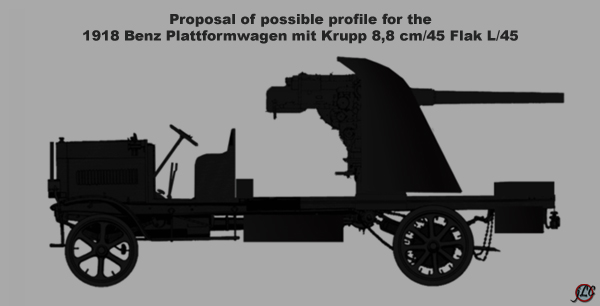
| General |
|
|
|
| Name(s): |
??? |
|
|
| Type: |
Self-propelled anti-aircraft gun on artillery tractor |
|
|
| Status: |
Production |
|
|
| Derived From: |
None |
|
|
| Derivatives: |
None |
|
|
| Produced: |
??? |
Production Date: |
??? |
| Producer(s): |
German Empire |
??? |
??? |
|
??? |
|
|
| Used: |
??? |
Service Date: |
??? |
| User(s): |
Duetches Heer (German Army) |
1918-11/1918 |
|
Full User(s) List
| – |
Unit |
Date |
Status |
| User(s): |
Duetches Heer (German Army) |
|
|
|
??? |
|
|
| Dimensions |
|
|
|
| Weight: |
??? t |
|
|
| Ground Pressure: |
??? kg/cm² |
|
|
|
Length |
Width |
Height |
| Vehicle: |
??? m |
??? m |
??? m |
| Ground Clearance: |
??? cm |
|
|
| Armaments |
|
|
|
|
# of |
Munition (Ammo #) |
Location(s), Type, Horizontal |
Type, Vertical |
Firing Rate |
1 x |
8,8cm Flak. L/45 (60) |
Pedestal, Mechanical, -/+???° @ 20°/s |
Mechanical, -10°/+70° @ ??°/s |
15 rpm |
| Ammunition |
|
|
|
|
Bullet |
Type |
Weight/Filler, Penetration @ Velocity |
|
8,8cm Sprgr. L/3,8 (Iz.) |
SAPHE |
10 kg/640 g Fp. 02 or Pieretic, 114 mm @ 795 m/s |
|
8,8cm Sprgr. L/3,9 |
HE-TF |
9.75 kg/582 g Fp. 02 & Np. 10, 13 mm @ 805 m/s |
|
8,8cm Sprgr. L/3,7 |
HE-TF |
9.75 kg/580 g Fp. 02 & Np. 10, 13 mm @ 805 m/s |
|
8,8cm Sprgr. L/3,6 (Kz.) |
HE-TF/HE-T-TF |
10 kg/560 g Fp. 02, 12 mm @ 795 m/s |
| Devices |
|
|
| # of - Name |
Type |
Effect, Location/for |
| 1 x - ??? |
Sight |
??x zoom, for 8,8cm Flak. |
| Protection |
|
|
| Location |
Thickness |
Type |
| All |
??? mm @ ??° |
??? |
| Turret |
15 mm @ ??° |
RHA |
| Crew |
|
| 5 |
Total |
| 1 |
Commander |
| 1 |
Driver |
| 1 |
Gunner |
| 2 |
Gun Loaders |
| Automotive |
|
|
|
| Fuel Capacity: |
??? l |
|
|
| Engine(s): |
1 x - ??? |
|
|
|
Type: |
Gasoline |
|
|
Horsepower: |
43 kW |
|
|
@ RPM |
??? |
|
|
Cylinder: |
??? |
|
|
Capacity: |
??? l |
|
|
|
Foward |
Reverse |
| Transmission: |
??? |
?? |
?? |
| Steering: |
??? |
|
|
| Brakes: |
??? |
|
|
| Suspension |
|
|
| Type: |
??? |
|
| Road wheels: |
4x2 |
|
|
Type: |
Spoked |
|
Steering: |
Front wheels |
| Mobility |
|
|
| Maximum Forward Speed: |
26.0 km/h |
|
| Maximum Reverse Speed: |
??? km/h |
|
| Power-to-Weight Ratio: |
??? kW/t |
|
| Maximum Grade: |
??° |
|
| Maximum Trench: |
??? m |
|
| Maximum Wall: |
??? m |
|
| Maximum Fording: |
??? cm |
|
| Minimum Turning Diameter: |
??? m |
|
| Cruising Range: |
??? km |
|
|
Mileage: |
??? l/100 km |
Summary
Benz-Gaggenau Typ 5 K trucks have been in service prior to the war and throughout the entirety of it. This was in various forms as utility trucks to artillery tractors. One such form, of which only an image survives, is of it serving as a carrier for a 8,8cm Flak. L/45 in a naval MPL C/13 mounting. It was destroyed on the Vesne Front in August of 1918.
Variants & Changes:
None
Images

Photograph of the destroyed gun carrier.
Raupenwagen LW
| General |
|
|
|
| Name(s): |
Lanz Raupenwagen LW |
|
|
| Type: |
Self-propelled anti-aircraft gun on artillery tractor |
|
|
| Status: |
Production |
|
|
| Derived From: |
None |
|
|
| Derivatives: |
None |
|
|
| Produced: |
149 (all versions) |
Production Date: |
1917-1918 |
| Producer(s): |
German Empire |
149 |
1917-1918 |
|
Heinrich Lanz AG |
149 |
1917-1918 |
| Used: |
??? |
Service Date: |
1917-11/1918 |
| User(s): |
Duetches Heer (German Army) |
1918-11/1918 |
|
Full User(s) List
| – |
Unit |
Date |
Status |
| User(s): |
Duetches Heer (German Army) |
|
|
|
??? |
|
|
|
??? |
|
|
| Dimensions |
|
|
|
| Weight: |
??? t |
|
|
| Ground Pressure: |
??? kg/cm² |
|
|
|
Length |
Width |
Height |
| Vehicle: |
??? m |
??? m |
??? m |
| Ground Clearance: |
??? cm |
|
|
| Armaments |
|
|
|
|
# of |
Munition (Ammo #) |
Location(s), Type, Horizontal |
Type, Vertical |
Firing Rate |
1 x |
7,62cm Flak. L/30 (60) |
Pedestal, Mechanical, -/+180° @ 20°/s |
Mechanical, -5°/+70° @ ??°/s |
20 rpm |
| Ammunition |
|
|
|
|
Bullet |
Type |
Weight/Filler, Penetration @ Velocity |
|
7,62cm St. Gr. |
HE/SAPHE |
6.0 kg/390 g Amatol, 9/50 mm @ 598 m/s |
|
7,62cm Flak. Gr. |
HE |
6.8 kg/340 g Fp. 70/30, 8 mm @ 590 m/s |
|
7,62cm Br. Shrap. Gr. |
ShI-TF |
6.8 kg/167 g Blackpowder, ??? mm @ 590 m/s |
| Devices |
|
|
| # of - Name |
Type |
Effect, Location/for |
| 1 x - ??? |
Sight |
??x zoom, for 7,62cm Flak. |
| Protection |
|
|
| Location |
Thickness |
Type |
| All |
??? mm @ ??° |
??? |
| Crew |
|
| 5 |
Total |
| 1 |
Commander |
| 1 |
Driver |
| 1 |
Gunner |
| 2 |
Gun Loaders |
| Automotive |
|
|
|
| Fuel Capacity: |
??? l |
|
|
| Engine(s): |
?? x - ??? |
|
|
|
Type: |
Gasoline |
|
|
Horsepower: |
60-75 kW |
|
|
@ RPM |
??? |
|
|
Cylinder: |
??? |
|
|
Capacity: |
??? l |
|
|
|
Foward |
Reverse |
| Transmission: |
??? |
?? |
?? |
| Steering: |
??? |
|
|
| Brakes: |
??? |
|
|
| Suspension |
|
|
| Type: |
??? |
|
| Road wheels: |
??? |
|
|
Type: |
??? |
|
Idlers: |
??? |
| Return rollers: |
??? |
|
|
Type: |
??? |
| Drive Sprockets: |
??? |
|
|
Type: |
??? |
| Tracks |
|
|
| Type: |
??? |
|
|
Shoes: |
??? |
|
Length:[/u] |
??? cm |
|
Width: |
??? cm |
|
Pitch: |
??? cm |
|
Depth: |
??? cm |
| Ground Contact: |
??? m |
|
| Mobility |
|
|
| Maximum Forward Speed: |
??? km/h |
|
| Maximum Reverse Speed: |
??? km/h |
|
| Power-to-Weight Ratio: |
??? kW/t |
|
| Maximum Grade: |
??° |
|
| Maximum Trench: |
??? m |
|
| Maximum Wall: |
??? m |
|
| Maximum Fording: |
??? cm |
|
| Minimum Turning Diameter: |
??? m |
|
| Cruising Range: |
??? km |
|
|
Mileage: |
??? l/100 km |
Summary
The Lanz Raupenwagen LW is likely the most obscure vehicle of the First World War, which is made odd due to its, relatively, large production count. It was produced as another tracked solution to artillery tractors and had four variations, of which at least one upgraded the vehicle with a stronger engine. However, visually they look identical and no documents exist to specify their actual differences. Based on photographs, at least one was converted into an anti-aircraft gun carrier in the same fashion as an Überlandwagen was. It is not known if this specific vehicle was equipped with the 80 hp (60 kW) or 100 hp (75 kW) engine.
Variants & Changes:
- Lanz Raupenwagen LW I: no known differences
- Lanz Raupenwagen LW II: no known differences
- Lanz Raupenwagen LW III: no known differences
- Lanz Raupenwagen LW IV: no known differences
Flakwagen A7V

| General |
|
|
|
| Name(s): |
??? |
|
|
| Type: |
Self-propelled anti-aircraft gun on tank |
|
|
| Status: |
Prototype |
|
|
| Derived From: |
Überlandwagen |
|
|
| Derivatives: |
None |
|
|
| Produced: |
3 |
Production Date: |
1918 |
| Producer(s): |
German Empire |
3 |
1918 |
|
Daimler-Motoren-Gesselschuft |
3 |
1918 |
| Used: |
3 |
Service Date: |
???-11/1918 |
| User(s): |
Duetches Heer (German Army) |
???-11/1918 |
|
Full User(s) List
| – |
Unit |
Date |
Status |
| User(s): |
Duetches Heer (German Army) |
|
|
|
??? |
|
|
| Dimensions |
|
|
|
| Weight: |
??? t |
|
|
| Ground Pressure: |
??? kg/cm² |
|
|
|
Length |
Width |
Height |
| Vehicle: |
??? m |
??? m |
??? m |
| Ground Clearance: |
??? cm |
|
|
| Armaments |
|
|
|
|
# of |
Munition (Ammo #) |
Location(s), Type, Horizontal |
Type, Vertical |
Firing Rate |
| Prototype #1/2 |
|
|
|
|
2 x |
7,62cm Flak. L/30 (60) |
Pedestal, Mechanical, -/+180° @ 20°/s |
Mechanical, -5°/+70° @ ??°/s |
20 rpm |
| Prototype #3 Early |
|
|
|
|
2 x |
7,7cm Flak. L/27 (60) |
Pedestal, Mechanical, -/+180° @ 20°/s |
Mechanical, -5°/+70° @ ??°/s |
20 rpm |
| Prototype #3 Late |
|
|
|
|
1 x |
7,7cm Flak. L/27 (60) |
Pedestal, Mechanical, -/+180° @ 20°/s |
Mechanical, -5°/+70° @ ??°/s |
20 rpm |
| Ammunition |
|
|
|
|
Bullet |
Type |
Weight/Filler, Penetration @ Velocity |
| 7.62 mm Gun |
|
|
|
|
7,62cm St. Gr. |
HE/SAPHE |
6.0 kg/390 g Amatol, 9/50 mm @ 598 m/s |
|
7,62cm Flak. Gr. |
HE |
6.8 kg/340 g Fp. 70/30, 8 mm @ 590 m/s |
|
7,62cm Br. Shrap. Gr. |
ShI-TF |
6.8 kg/167 g Blackpowder, ??? mm @ 590 m/s |
| Devices |
|
|
| # of - Name |
Type |
Effect, Location/for |
| Prototype #1/2 |
|
|
| 2 x - ??? |
Sight |
??x zoom, for 7,62cm Flak. |
| Prototype #3 Early |
|
|
| 2 x - ??? |
Sight |
??x zoom, for 7,7cm Flak. |
| Prototype #3 Late |
|
|
| 1 x - ??? |
Sight |
??x zoom, for 7,7cm Flak. |
| Protection |
|
|
| Location |
Thickness |
Type |
| All |
??? mm @ ??° |
RHA |
| Crew |
|
| 8 |
Prototype #1/2, & #3 Early |
| 1 |
Commander |
| 1 |
Driver |
| 2 |
Gunners |
| 4 |
Gun Loaders |
| 5 |
Prototype #3 Late |
| 1 |
Commander |
| 1 |
Driver |
| 1 |
Gunners |
| 2 |
Gun Loaders |
| Automotive |
|
|
|
| Fuel Capacity: |
??? l |
|
|
| Engine(s): |
2 x - Daimler 165-204 Typ 75 Kw. |
|
|
|
Type: |
Gasoline |
|
|
Horsepower (Total): |
75 (149) kW |
|
|
@ RPM |
??? |
|
|
Cylinder: |
4 |
|
|
Capacity: |
17 l |
|
|
|
Foward |
Reverse |
| Transmission: |
Adler 3-speed |
3 |
3 |
| Steering: |
??? |
|
|
| Brakes: |
??? |
|
|
| Suspension |
|
|
| Type: |
Vertical spring |
|
| Road wheels: |
24/6 |
|
|
Type: |
Rigid non-spaced |
|
Idlers: |
Front track |
| Return rollers: |
0 |
|
|
Type: |
N/A |
| Drive Sprockets: |
2 |
|
|
Type: |
19-tooth rear drive |
| Tracks |
|
|
| Type: |
Continuous linked steel |
|
|
Shoes: |
??? |
|
Length:[/u] |
??? cm |
|
Width: |
??? cm |
|
Pitch: |
??? cm |
|
Depth: |
??? cm |
| Ground Contact: |
??? m |
|
| Mobility |
|
|
| Maximum Forward Speed: |
12.1 km/h |
|
| Maximum Reverse Speed: |
6.3 km/h |
|
| Power-to-Weight Ratio: |
??? kW/t |
|
| Maximum Grade: |
???° |
|
| Maximum Trench: |
2.2 m |
|
| Maximum Wall: |
0.45 m |
|
| Maximum Fording: |
70 cm |
|
| Minimum Turning Diameter: |
??? m |
|
| Cruising Range: |
??? km |
|
|
Mileage: |
??? l/100 km |
Summary
The Flakwagen A7V is a mysterious prototype, namely because nothing survived of it aside from its photographs. What is known is that it’s an Überlandwagen modified with a slightly longer hull to accommodate the anti-aircraft guns and that at least three prototypes were constructed, each in a different configuration. It is rumored that at least one was sent to the Western Front as a part of an anti-aircraft battery, but aside from that it is thought they were simply scrapped at the end of the war.
Variants & Changes:
- 1918: Second prototype constructed; armored cover for driver and commander replaced by canvas cover
- 1918: Third prototype constructed; 7,62cm Flak. L/30 replaced by 7,7cm Flak. L/27 and canvas cover bars removed
- 1918: canvas cover bars installed
- 1918: canvas cover bars and rear 7,7cm gun removed
Variant Images

Initial prototype.

Second prototype, with armor covers around driver and commander removed.

Third prototype, with doors open and canvas cover bars removed.

Third prototype, with doors open and canvas cover bars reinstalled.

Third prototype, with doors closed and rear 7.7cm gun and canvas cover bars removed.




























